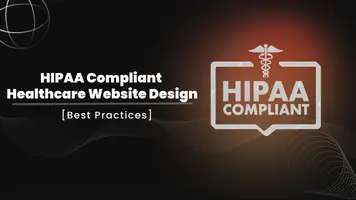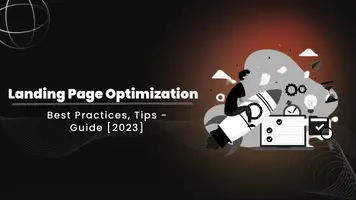Loveneet singh
Common HIPAA Violations to Avoid in 2024: Examples and Tips
Common HIPAA Violations to Avoid in 2024
HIPAA compliance is a critical aspect of protecting patients' sensitive health information as per PHI (protected health information) and Electronic Protected Health Information (ePHI).

The Department of Health and Human Services Office for Civil Rights (OCR) pursues settlements with covered entities and business associates to highlight common HIPAA violations and emphasize the need for compliance.
According to HIPAA breach report for February 2023, protected health information (PHI) breaches affecting 500 or more people as reported to the Department of Health and Human Services (HHS) in January 2024.
With the increasing number of data breaches, it is more important than ever for covered entities to ensure their compliance with HIPAA regulations and protect their patients' privacy.
This article will provide valuable insights into the most common HIPAA violations and how to avoid them, helping healthcare organizations reduce the risk of costly settlements and damage to their reputation.
10 Common HIPAA Violations to Avoid in 2024
It's essential to follow the HIPAA Privacy Rule to prevent violations. Whether you are a healthcare service provider, or doctor, or own a clinic, ensure a regular review of your medical website design. This will provide patients' data and records security.
To help you stay on top of HIPAA compliance and avoid costly mistakes, we've compiled a list of common violations to watch out for when designing a website or mobile app.
-
VIOLATION #1 - A Non-Encrypted Lost or Stolen Device
One of the most common HIPAA violations is the loss or theft of an unencrypted device that contains protected health information (PHI). If your healthcare organization is not properly encrypting devices that store PHI, you're putting your patients' sensitive data at risk.
For example, in 2019, the healthcare provider Bayfront Health St. Petersburg was fined $85,000 after a laptop containing the PHI of over 6,000 patients was stolen from an employee's car. The laptop was not encrypted, making it easy for the thief to access the sensitive information. This incident highlights the importance of encrypting devices to protect patient information and avoid costly HIPAA violations.
-
VIOLATION #2 - Failure to conduct a risk analysis
When the websites are using third-party software, it has to be a risk-free integration. Prior check and risk analysis is required, The authorization to avoid violation of HIPAA rules is a must.
As an example of HIPAA violation, the Department of Health and Human Services (HHS)(2019)- a nurse accessing a celebrity's medical records out of curiosity, without any medical reason or proper authorization, resulted in a $1.2 million settlement with the Department of Health and Human Services (HHS). This incident highlights the importance of proper authorization to avoid consequences.
-
VIOLATION #3 - Failure to Provide Patient's Medical Records
Patients can view their medical records as per regulations. If any website is violating this rule, a patient can take action and can file a complaint against it. At the same time, if any registered record is found missing then also, it is a violation of the rules.
As per records of the U.S. Department of Health and Human Services, a Florida healthcare provider was fined $85,000. The provider failed to provide a patient with access to their medical records within the required 30-day timeframe. This case clearly states the importance of maintaining the records.
-
VIOLATION #4 - Inadequate Physical or Technological Security Measures
HIPAA-compliant websites are required to follow adequate physical and technological security measures. It is necessary to preserve the patient's information online and offline. Having a secure physical (hardware security) setup as well as web security is vital. Any security compromise for websites like not checking security threats or malware is a violation of HIPAA rules.
To know more about HIPAA Compliance, follow our HIPAA-compliant Checklist for Website Development
According to the HIPAA Journal, in 2021, the healthcare industry experienced a surge in cyberattacks, with a 37% increase in reported data breaches. These breaches included incidents where healthcare organizations failed to implement proper technical security measures, such as using weak passwords or failing to install necessary software updates.
These incidents demonstrate the critical importance of implementing adequate technological security measures to prevent data breaches and HIPAA violations.
-
VIOLATION #5 - Improper Disposal of Patient Records
Improperly disposing of patient records, such as throwing them in the trash instead of shredding them, is a common HIPAA violation that can result in a data breach. Make sure your healthcare organization has proper protocols in place for the secure disposal of patient records.
According to the Department of Health and Human Services (HHS), improper disposal of patient records was one of the top five causes of HIPAA violations in 2020. In one notable case, a provider paid $100,000 in fines after leaving 3,200 patient records in an unlocked truck that was stolen. This incident highlights the importance of proper disposal methods to prevent unauthorized access to patient information.
-
VIOLATION #6 - Lack of Employment Training
The website development team must be trained to avoid HIPAA violations. Failure to provide adequate training can lead to mistakes. The users will not be able to trust the healthcare service.
As mentioned in one of the reports published by the US Department of Health and Human Services. A healthcare provider in California was fined $3 million for multiple HIPAA violations. He hired an untrained team without knowledge of PHI regulations. As a result, the patient’s data was hacked.
-
VIOLATION #7 - Failure to Conduct Regular Risk Assessments
Conducting regular risk assessments is necessary to identify potential vulnerabilities in your healthcare organization's security systems. Failure to do so can lead to undetected security threats and HIPAA violations.
For instance, in a recent case, a healthcare provider in Texas was fined $1.6 million for multiple HIPAA violations, including failure to conduct regular risk assessments. The Office for Civil Rights found that the provider had not conducted an enterprise-wide risk analysis to identify potential risks and vulnerabilities to the confidentiality, integrity, and availability of electronically protected health information.
This case underscores the importance of regular risk assessments to prevent potential security breaches and HIPAA violations.
-
VIOLATION #8 - Gossiping/Sharing PHI
As per the PHI guidelines, any website or app is not allowed to share the patient’s information without taking their consent. The web developers developing the HIPAA websites, website owners and project managers must understand these restrictions obeying the confidentiality rules. There can be severe consequences if any data breach occurs.
For example, a healthcare employee in New York was terminated and fined $15,000 for sharing the personal health information of a patient with unauthorized individuals. The employee accessed the patient's medical record without authorization and then shared the information with friends and family members.
The Office for Civil Rights found that the healthcare provider did not adequately train its employees on HIPAA regulations and the importance of maintaining patient confidentiality. This case demonstrates the importance of proper training and monitoring of employees to prevent unauthorized access and disclosure of protected health information.
VIOLATION #9 - 3rd Party Disclosure for Payments
Healthcare websites are connected with third-party vendors for eCommerce transactions. For that users are required to provide their personal information. The third-party gateway must sign a disclosure agreement ensuring the security of personal records while making transactions as per HIPAA.
Check out our HIPAA compliance checklist for Mobile App Development to get more details.
For instance, a health insurance provider in California was fined $2.5 million for sharing the protected health information of more than 1 million patients with a third-party vendor without proper authorization. The vendor was not authorized to receive the information and did not have appropriate safeguards in place to protect the data.
The Office for Civil Rights found that the health insurance provider did not have appropriate agreements in place with the third-party vendor to ensure compliance with HIPAA regulations. This case emphasizes the importance of carefully vetting third-party vendors and establishing proper agreements to protect patient privacy and comply with HIPAA regulations.
VIOLATION #10 - Preservation of Records as per PHI
Under HIPAA regulations, healthcare organizations must maintain a database of old records for a given time. The healthcare website has to pay heavy fines or penalties if records are found missing.
For example, a healthcare provider was fined $111,400 for failure to maintain the privacy and security of patient records. The provider had disposed of paper records containing personal information. It resulted in a breach of patient privacy.
The Office for Civil Rights found that the healthcare provider did not obey policies and procedures to ensure the proper disposal of patient records. This case highlights the importance of proper record retention policies.
Consequences of HIPAA Violations
HIPAA violations can lead to severe consequences for healthcare organizations and individuals. Monetary penalties for HIPAA violations can range from thousands to millions of dollars depending on the severity of the breach. Healthcare organizations must take HIPAA violation lawsuits seriously and prioritize compliance, including in their healthcare website design, to avoid these consequences.
-
Monetary Penalties
HIPAA violations can result in significant monetary penalties for healthcare organizations and individuals. The Office for Civil Rights can impose fines ranging from $100 to $50,000 per violation, up to a maximum of $1.5 million per year for each violation type. These penalties can have a severe impact on the financial health of healthcare organizations.
-
Criminal Charges
In severe cases, criminal charges can be imposed for violating HIPAA regulations. The individual information sharing/copying and selling under PHI provisions comes under criminal charges.
-
Civil Lawsuits
Patients whose privacy rights have been violated due to HIPAA violations may file civil lawsuits seeking damages. These lawsuits can result in significant financial losses for healthcare organizations, including damages for emotional distress, loss of reputation, and loss of income.
-
Damage to Reputation and Business Operations
HIPAA violations can result in significant damage to the reputation and business operations of healthcare organizations. Patients may lose trust in the organization, and the resulting negative publicity can lead to a decrease in patient volume and revenue. Moreover, healthcare organizations can also face legal action, regulatory scrutiny, and loss of business opportunities due to a breach of HIPAA regulations.
Tips to Avoid HIPAA Violations
Healthcare organizations and individuals need to prioritize compliance with HIPAA regulations to protect patient's privacy and avoid the severe consequences of violations
To avoid HIPAA violations, healthcare organizations should consider the following tips:
-
Employee Training and Education
Proper training and education of employees is essential to prevent HIPAA violations. Workforce training should include employees’ responsibilities. Formal training regarding the HIPAA Privacy Rule, HIPAA Security Rule, and Business Associate Agreement (BAA) must be provided to employees to avoid the consequences of violating HIPAA regulations.
-
Regular Risk Assessments and Security Audits
Conducting regular risk assessments and security audits can help healthcare organizations identify potential vulnerabilities. In case there are threats, you can take action to resolve them. For healthcare website development, the developers must follow a defined policy with an authentic system to implement password management and mobile device management. Also, social media policies must be defined according to permissions to avoid the violation of HIPAA rules.
-
Implementation of Secure Technological Measures
Implementation of secure technological measures, such as encryption, firewalls, and access controls, can help protect patient data from unauthorized access and disclosure. Including security to check records with high-end techniques such as data encryption will help in developing a secure website. With time, the database is likely to increase, the website must have a data backup and recovery plan.
-
Proper Disposal of Patient Records
Healthcare organizations should establish policies and procedures for the disposal of paper and electronic records on their website taking the patient’s consent. you can remove a record after a fixed time. In case you are updating the database software, you can take a backup of old records. This way you can maintain a smooth and speedy service.
-
Establishment of a Clear Privacy Policy
A clear privacy policy should be established, communicated to employees, and made available to patients. The policy should outline how patient information is collected, used, disclosed, and protected, as well as the rights of patients to access and amend their information. Notice of Privacy Practices must be clearly displayed on the website to avoid confusion about the privacy policy. The data breach consequences must be clearly defined in the privacy rules.
Partner with a HIPAA-compliant web development agency to avoid violations and consequences
In conclusion, protecting patient privacy is also a key responsibility of any healthcare organization. Don't wait until a data breach occurs to prioritize patient privacy. Take action now and partner with a HIPAA-compliant website development agency to safeguard your patients' sensitive information.
By doing so, you'll not only protect your patients, but you'll also protect your organization's reputation and avoid costly fines. One such reputed organization is RedBlink which has prior experience in developing HIPAA-compliant websites and taking the first step toward secure and compliant online systems. Book an appointment to get started!
Redblink is a leading healthcare website design agency that specializes in developing HIPAA-compliant mobile apps and websites for dermatology, pediatrics, pharmacy, and other healthcare professionals.
Generative AI in Product Design & Development - Benefits & Tips
Generative AI Product Design
Introduction to Generative Design
Generative design is a new approach to design that uses algorithms and AI-powered software to create and optimize product designs. It is a departure from traditional design methods, which typically involve a designer creating a product design based on a set of requirements and constraints.
Generative design, on the other hand, involves defining a set of design goals and constraints and letting a computer algorithm generate a range of possible design options that meet those criteria. This approach allows for more creative exploration of design possibilities while also streamlining the design process.
Generative AI in Design and Engineering
Generative design is being used in a wide range of industries, from automotive and aerospace to consumer goods and architecture. In the automotive industry, for example, generative design is being used to create lightweight and efficient parts that reduce fuel consumption.
To improve performance, weight reduction plays a vital role, and the Briggs Automotive Company (BAC) has effectively utilized generative design to optimize and fabricate innovative wheels for its street-legal race car, the BAC Mono. By using this technology, the BAC Mono's wheels are now more lightweight, durable, and stronger than ever before.
As a result, the car's acceleration and handling have significantly improved, providing a more thrilling and exhilarating driving experience. The use of generative design not only improved the car's performance but also reduced production costs and time, making it an excellent example of how innovative technology can enhance the automobile industry.
In architecture, generative design is being used to create complex building structures that are optimized for energy efficiency and structural stability. In the consumer goods industry, generative design is being used to create products that are not only aesthetically pleasing but also more efficient and sustainable.
Generative design plays a significant role in manufacturing by automatically generating design options that meet your requirements, improving efficiency. This is especially important when parts or tools must fit into an established workflow or pipeline, where retooling can be disruptive and expensive.
With generative design software such as Autodesk Fusion 360, designers can explore countless variations to minimize weight or material costs, maximize performance metrics, and experiment within tight restrictions. Introducing generative design to existing manufacturing processes such as additive manufacturing, CNC machining, and casting can enhance product performance, reduce costs, and enable exploration of innovative design concepts. By leveraging the benefits of generative design, manufacturers can optimize their processes and stay ahead in the highly competitive manufacturing industry.
Benefits of Generative Design
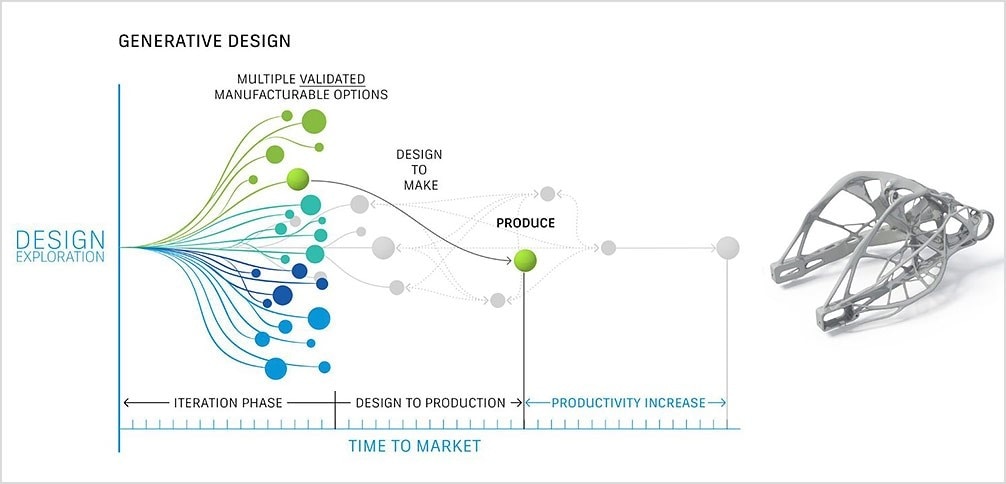
One of the main benefits of generative design is that it allows designers to quickly generate and evaluate a large number of design options. This can help speed up the design process and reduce costs by eliminating the need for manual design iterations.
Generative design can also help identify design options that may not have been considered using traditional design methods. By exploring a wider range of design possibilities, designers can create more innovative and efficient products.
Another advantage of generative design is that it can be used to optimize designs for specific manufacturing processes or materials. By taking into account manufacturing constraints from the outset, generative design can help create products that are easier and cheaper to produce.

Generative AI Product Design - Case Studies
One example of a successful project that utilized generative design is Airbus' A320neo aircraft. The company used generative design to optimize the design of the aircraft's wingtip, resulting in a 3.5% reduction in fuel consumption.
Another example is the Adidas Futurecraft 4D shoe. Adidas used generative design to create a lattice-like structure in the sole of the shoe, which provides cushioning and support while also being lightweight and durable.
The Future of Generative Design
As AI technology continues to improve, we can expect to see even more advancements in generative design in the coming years. One potential area of development is the ability to incorporate real-time feedback from sensors and other sources into the design process, allowing for more dynamic and responsive product designs.
Another area of development is the use of generative design for multi-disciplinary design optimization. This involves optimizing not just the product design itself but also the manufacturing process, materials, and supply chain.
Ethical Considerations
As with any emerging technology, there are ethical implications to consider when it comes to generative design. One potential issue is the displacement of human designers and engineers. As generative design becomes more sophisticated, there is a risk that it could replace the need for human designers altogether.
Another potential ethical issue is the potential for generative design to create products that are optimized for efficiency and cost savings at the expense of other factors, such as safety or environmental impact. It will be important for companies to ensure that ethical considerations are taken into account when using generative design.
Tips for Implementing Generative Design
For companies interested in adopting generative design, there are a few best practices to keep in mind. First, it's important to have a clear understanding of the design goals and constraints before beginning the generative design process.
It's also important to have a team of designers and engineers who are familiar with the generative design software and can provide feedback and guidance throughout the process. Finally, It's important to evaluate and test the generated designs thoroughly to ensure that they meet all the necessary requirements and are feasible to manufacture.
Another key consideration when implementing generative design is the need for high-quality data. Generative design algorithms rely on accurate data inputs to create effective designs, so it's important to ensure that the data being used is reliable and up-to-date.
Finally, it's important to recognize that generative design is not a one-size-fits-all solution. While it can be a powerful tool for certain design applications, there may be situations where traditional design methods are still more appropriate. Companies should carefully consider their specific design needs and constraints before deciding to adopt generative design.
Conclusion
Generative design is a powerful new approach to product design that offers numerous benefits over traditional design methods. By using algorithms and AI-powered software to generate and optimize design options, generative design can help streamline the design process, reduce costs, and create more innovative and efficient products.
While generative design is still a relatively new technology, it is already being used in a wide range of industries, from aerospace to consumer goods. As AI technology continues to improve, we can expect to see even more advancements in generative design in the coming years.
As with any emerging technology, there are also ethical considerations to keep in mind when it comes to generative design. Companies should take care to ensure that their use of generative design is ethical and takes into account potential risks and implications.
Overall, generative design represents an exciting new frontier in product design, and companies that are able to successfully adopt and integrate generative AI into their design processes will be well-positioned for success in the years to come.
Elevate Your Product Design with RedBlink
RedBlink specializes in providing end-to-end product design services to businesses across various industries. Their services range from
- Concept development
- Prototyping to Development / testing
Here are some ways in which we can help you in product design:
User-Centered Design: At RedBlink we follow a user-centered design approach that puts the end-users at the center of the design process. We conduct user research to understand the user's needs, behaviors, and preferences. This helps in designing products that are intuitive, easy to use, and provide a great user experience.
Design Thinking: RedBlink uses a design thinking approach that involves empathizing with the user, defining the problem, ideating possible solutions, prototyping, and testing. This iterative process helps in creating products that meet the user's needs and solve their problems.
Rapid Prototyping: RedBlink uses rapid prototyping techniques to quickly build and test multiple design iterations. This helps in identifying design flaws early in the design process and reducing the overall development time.
Technical Expertise: We have a team of experienced designers, engineers, and developers who have expertise in various technologies and tools. This helps in designing products that are feasible, scalable, and can be manufactured at a reasonable cost.
Manufacturing Support: RedBlink provides product design & development support to businesses. We ensure that the designed product is useful as per the market needs. We carefully work with companies to cater to their product needs meeting the desired quality standards.
Want to incorporate the power of Generative AI into your product design and development process? Looking to hire ChatGPT developers? RedBlink can help businesses in designing products that are user-friendly, innovative, and cost-effective.
At RedBlink, we specialize in harnessing the capabilities of Generative AI to revolutionize the world of product design and development. Our team of skilled ChatGPT developers can help you unlock new possibilities and streamline your creative process. Visit our website today to learn more about our services and explore how our ChatGPT developers can bring your ideas to life. Take the first step towards transforming the way you design and develop products with Generative AI!
RedBlink, a prominent Generative AI Development Company, is your go-to provider for cutting-edge web application software and building generative AI solution. Our expertise lies in leveraging state-of-the-art generative AI applications to foster innovation and drive growth.
References:
- Autodesk. (n.d.). Generative design in manufacturing. Retrieved from https://www.autodesk.com/solutions/generative-design/manufacturing
- Airbus. (2016). A320neo Wingtip Design – Generative Design. Retrieved from https://www.airbus.com/en/newsroom/news/2016-03-pioneering-bionic-3d-printing
- Adidas. (n.d.). Futurecraft 4D. Retrieved from https://www.adidas.com/us/futurecraft
- BAC Mono. (n.d.). Mono R. Retrieved from https://www.bac-mono.com/new-page-82
- McCracken, H. (2018). Generative Design: A New Method for Creating Unique Products. Forbes. Retrieved from https://www.forbes.com/sites/premium-video/2023/03/22/2023-forbes-3050-summit-opening-fireside-a-master-class-on-breaking-barriers/
Medical Website Design - Best Web Designing Tips for Health Websites
Medical Website Design
94% of patients rely on online reviews to evaluate the services of healthcare providers.
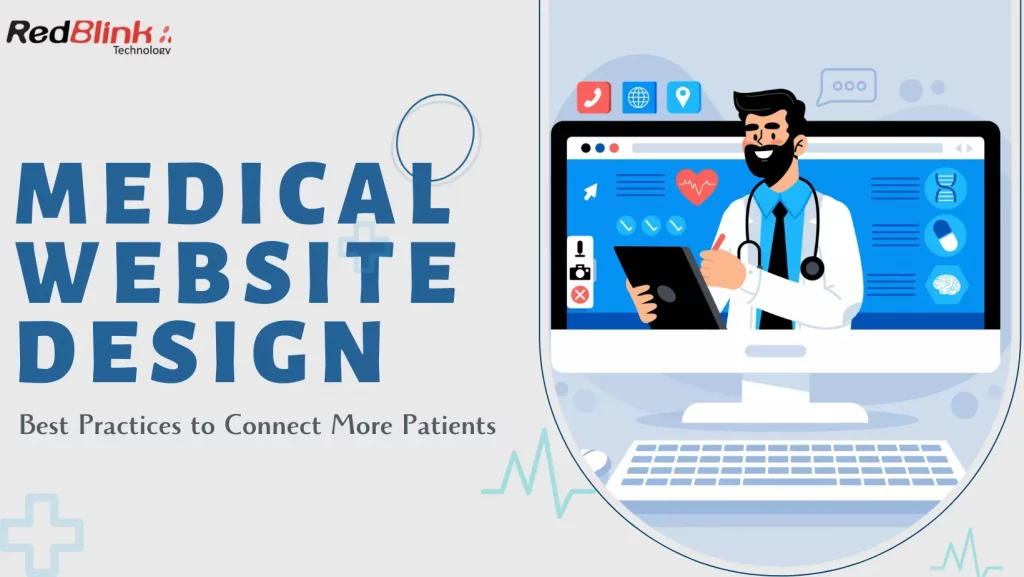
The first step towards running a successful medical business is by developing a website that is accessible to patients 24/7.
Ranking high on search engines enables hospitals, clinics, and doctors to showcase their services and grab the attention of new patients. With the rise of telemedicine, many healthcare service providers are designing their websites to offer online consultations and more, making it easier than ever to connect with patients.
While word-of-mouth referrals are certainly valuable, having a robust medical website ensuring a solid digital presence allows health service providers to establish virtual doctor-patient relationships by building trust with patients.
“From Search to Scheduling an appointment: The Role of Doctor’s Website in Delivering Best Healthcare Services has become the norm for most patients. Creating an online platform with accurate medical information can significantly impact potential patients.”
That’s why, here in this article, we are outlining key tips that must be considered while redesigning /designing medical websites.
Revamp Your Medical Website Design : Why It's Crucial for Attracting and Retaining Patients
Looking at the facts, according to Moz, the first page of Google captures 71% of search traffic clicks, with the first five results accounting for 67% of all clicks. This highlights the importance of having a high ranking on search engine results pages (SERPs) to drive traffic to a website and reach the target audience effectively.
For developing medical websites, the best practice is to hire a leading healthcare website design agency to improve user-friendliness and productivity. However, redesigning a traditional website with the latest trends will not only improve the patient experience but also enhance the online presence of their practice.
A well-designed medical website can provide patients with easily accessible call-to-actions to important information and drive leads, such as appointment scheduling, office locations, and medical services. An engaging website serves as a virtual assistant for patient engagement, through features such as secure messaging, chatbots, and patient portals.
For a profitable medical business, a redesign of a website by adding more features is like a makeover to attract more visitors and improve search engine rankings.
Let’s explore some factors to consider while redesigning a medical website for better customer engagement:
-
Unable to reach your target Audience/ low website traffic
If a medical website is not receiving a significant amount of traffic, it could mean that they are not reaching its target audience effectively. This could be due to a variety of factors, such as website design having long content which is unable to attract the target audiences, unoptimized images, etc.
A redesign of the website could help address these issues and improve the website’s ability to attract and engage with the target audience.
-
Branding is missing or outdated
Are you concerned that your current website is not effectively showcasing your doctor's business or building your service brand? If so, it may be time to consider a redesign. To ensure your website stays up-to-date, make sure to regularly evaluate design elements such as the logo, color scheme, and typography.
If any of these elements are missing or outdated, it's definitely time for a redesign. A functional website is essential in building a brand that accurately reflects your business's values and services.
By maintaining consistent branding across all marketing materials, you can create a recognizable image for your business. Prioritizing branding during website redesign can help you create an effective and memorable online presence.
-
The website design is outdated
A healthcare website has to be updated due to several reasons such as cluttered design, no call-to-actions, unresponsive design, layout, the design being too old, content not informative, and so on. Due to these reasons, you lose your business to your competitors. In such cases, you should consider redesigning your website.
If you don’t decide to revamp an old website at the right time, it will discourage potential patients. A redesign will improve website engagement, credibility, and trust of potential clients.
-
No or Low Search Engine Rankings
Search engine rankings play a crucial role in how patients find healthcare providers online. If a healthcare website is not ranking well in search engine results, it can be challenging to attract new patients.
A redesign of the website can incorporate best practices for search engine optimization (SEO) to improve SERP results, making it easier for potential patients to find the website and the practice.
Key Considerations for Medical Website Design: Best Practices for Redesigning
A medical website should be designed as per HIPAA regulations. Whether you are a solo practitioner or a hospital, having a UX/UI website can improve your image and potentially draw in new patients.
Here are 10 tips to keep in mind when redesigning or designing your medical website. Incorporating these key considerations can result in a website that effectively meets the needs of your patients and potential patients.
1. Develop a HIPAA Compliant Website
Healthcare service providers should ensure that their website complies with HIPAA regulations to protect the privacy and security of (PHI) patient health information. As a website owner, the doctor or hospital can choose a secure hosting service with SSL certification. This can protect the data and help a doctor’s website in compliance with HIPAA.
According to a survey conducted by the American Medical Association (AMA), 83% of physicians reported experiencing a cyber attack in their practice, with 55% experiencing multiple attacks. Additionally, 28% of physicians reported that their practice had experienced a data breach.
2. Design a website with Mobile- First Approach
Mobile phone users worldwide are expected to reach 7.33 billion by 2024 (source: Statista).
With an increasing number of people using their mobile devices to access the internet, it’s important to design a responsive website to connect mobile users to your heal services.
In fact, a study conducted by Google found that 61% of users are unlikely to return to a mobile site they had trouble accessing, and 40% will visit a competitor’s site instead.
Designing a mobile-friendly website will improve user experience and potentially prevent patients from going to a competitor’s website.
3. Include SEO Optimized Content
In addition to improving search engine rankings and attracting more visitors, SEO-optimized content can also increase patient engagement and trust.
According to a survey conducted by Software Advice, over 60% of patients said that online reviews and ratings influenced their decisions when choosing a healthcare provider.
By providing informative and engaging content on their websites, healthcare service providers can establish themselves as thought leaders in their respective fields, building trust and credibility with potential patients.
Simply put, having a strong online presence and optimized content can lead to higher patient retention rates and more referrals, ultimately resulting in a more successful medical practice.
By prioritizing SEO-friendly content on their websites, hospital owners can not only improve their online visibility but also build a stronger connection with their patients and community.
4. Simple Navigation of the Website
A website's navigation plays a crucial role in user engagement and retention.
According to a report by Nielsen Norman Group, a leading user experience research firm, users tend to leave websites within 10 to 20 seconds if they can't find what they're looking for.
Therefore, it’s essential to design a website with a simple navigation system, allowing patients to quickly and easily find the information they need.
The web design must have clear and concise menus, logical grouping of information, and intuitive labeling of links and buttons. A simple and easy-to-use website can also improve patient satisfaction and loyalty.
5. Identify and Convey Your Brand Messaging
A doctor’s website should portray the expertise area and specialization of the doctors. While you hire a website development company make sure the content to highlight your services is written in an engaging form.
For example, a cardiologist can advertise their experience by using real-time case studies of treating patients. A pediatrician can highlight unique approaches to treating children.
Additionally, hospitals and clinics can use their website to communicate their brand messaging by showcasing patient testimonials and sharing their success stories to build trust and credibility with potential patients.
6. Focus on UX/UI Design
A medical website should have a visually appealing UI/UX. This can be achieved by using a clean, modern design that incorporates white space and high-quality images. To enhance UX, website developers must incorporate intuitive navigation menus and features, such as appointment scheduling tools and patient portals.
Additionally, optimizing healthcare websites for fast loading speeds on the web and different devices is crucial in today’s mobile-first era, where more than 50% of website traffic comes from mobile devices.
7. Use Lead Generation Forms for Appointment Requests
Lead generation forms serve as a bridge between potential patients and healthcare providers by enabling patients to submit their contact information and appointment preferences. This simplifies the appointment scheduling process and can lead to improved lead generation for doctors.
Lead generation forms help in creating a customer database that reduces the chances of missed appointments.
As an example, consider a dermatology clinic in a busy urban area that wants to increase patient bookings and reduce the rate of missed appointments. They decide to implement lead forms on their website, social media, and other marketing channels.
Within 2-3 months, they witness an increase in bookings by 25-30%.
8. Feature Patient Testimonials
Patient testimonials are an effective way for doctors to build trust and credibility with potential patients. By featuring patient reviews and ratings on their website, doctors can demonstrate their expertise and showcase their ability to provide quality care.
A website providing medical services can also use patient testimonials to highlight successful case studies, such as stories of patients who have achieved successful outcomes after receiving treatment.
The survey conducted by Software Advice, (a healthcare technology research firm)- 72% of patients use online reviews as their first step in finding a new doctor.
Approximately, 84% of patients trust online reviews as much as personal recommendations from friends or family. This means adding testimonials to your website will give more credibility to the website.
9. Tell About the Services
The health-related services and area of expertise should be clearly visible on the website. This will help boost the business. When choosing a website development agency, make sure they have previously worked in the healthcare domain.
The specific approach can lead to a better design as per the requirement. Additionally, providing comprehensive information about services on their website can help doctors stand out in a competitive market and differentiate themselves from other healthcare providers.
For example, a dermatologist can provide detailed information about the various skin conditions they treat, while a fertility specialist can explain their approach to fertility treatment and the range of services they offer.
10. Opt for Local SEO
Optimizing a medical website for local search is important for improving local outreach. As an owner, you must ensure that your website is optimized by implementing local SEO strategies. It is possible to improve a doctor’s service in nearby areas by using local keywords.
For example, a pediatrician in New York City can include location-specific keywords like “pediatrician in NYC” or “pediatric care in New York” to rank higher in local search results.
Additionally, medical business owners can use Google Business Profile (GBP) along with their website to manage their online presence and provide up-to-date information about their practice, including their location, hours of operation, and services offered.
Conclusion- Grow your Practice with Medical web design ?⚕️!
In conclusion, a UX/UI website will help a medical website reach target audiences. As a doctor, you can ensure that effective local SEO practices are implemented on the website.
To ensure compliance with HIPAA regulations, it is important to select a full-stack development agency with a proven track record in designing UX websites that meet these standards. With RedBlink’s HIPAA-compliant UX/UI design services, doctors can rest assured that their websites will be designed with the highest level of security and privacy in mind.
Trust RedBlink to deliver a website that not only looks great but also protects patient data and confidentiality.
Redblink is a leading healthcare website design agency that specializes in developing HIPAA-compliant mobile apps and websites for veterinarians, dentists, orthopedists, and other healthcare professionals.
Generative AI vs Machine Learning vs Deep Learning Differences
Generative AI Vs Machine Learning Vs Deep Learning
Artificial Intelligence (AI) refers to the ability of machines to perform tasks that typically require human intelligence, such as understanding natural language, recognizing images, and making decisions. It is a broad field that includes many different techniques and applications, including machine learning, natural language processing, robotics, and computer vision.
AI systems are designed to learn from data and improve their performance over time, making them more effective and efficient at solving complex problems. They can be used in a wide range of applications, from healthcare and finance to transportation and manufacturing.
Some of the key benefits of AI include:
- Improved accuracy and efficiency
- Increased productivity and automation
- Enhanced decision-making and problem-solving capabilities
- Reduced costs and resource requirements
However, there are also concerns about the ethical implications of AI, particularly in areas such as privacy, security, and bias.
In this post, we will dive deep into the distinctions between generative AI, machine learning, and deep learning. We'll explore their unique characteristics, applications, and how they contribute differently to the field of AI. By understanding the strengths and limitations of each, you can better appreciate their roles in shaping the future of technology.
"Discovering Generative AI - A Captivating White Paper"
What is Generative AI?
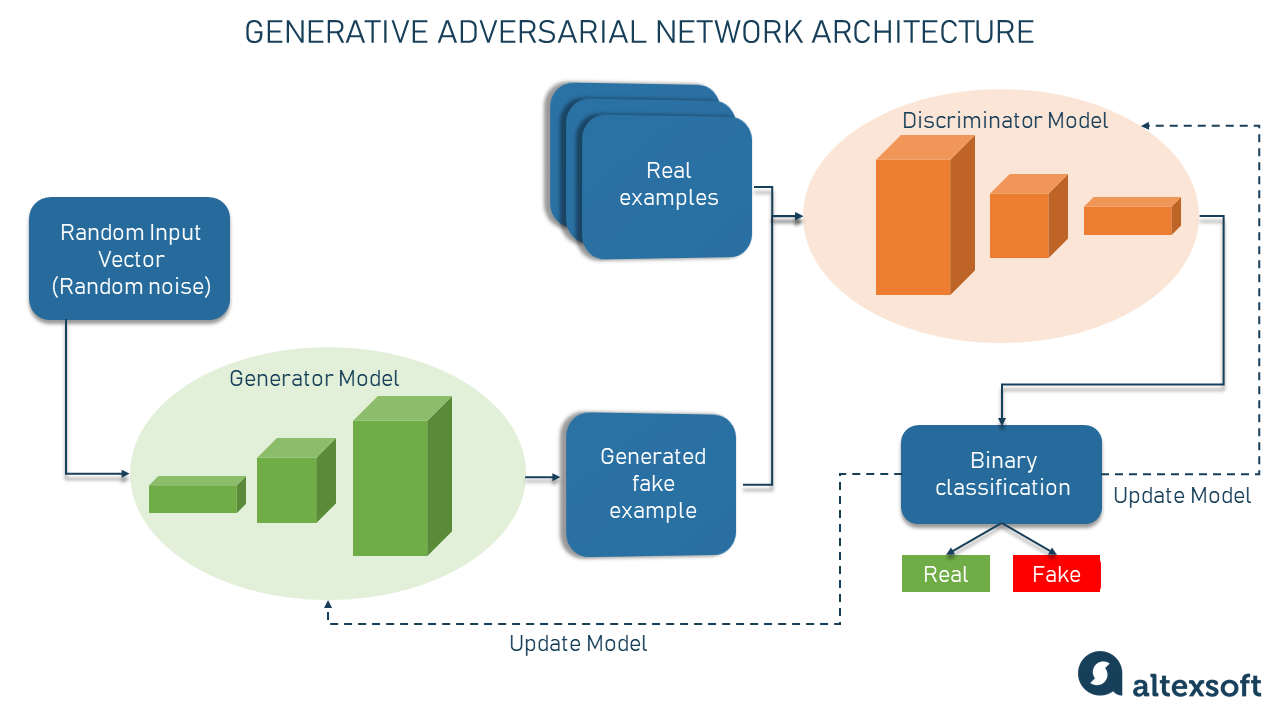
Source - altexsoft.com
Generative AI refers to a subset of AI that focuses on creating new and original content rather than simply recognizing or analyzing existing data. Unlike traditional machine learning algorithms that are programmed to make predictions based on a given set of data, generative AI algorithms are designed to create new data. This could be in the form of images, text, music, or even entire video clips. This includes techniques such as generative adversarial networks (GANs) and variational autoencoders (VAEs).
GANs consist of two neural networks: a generator and a discriminator. The generator learns to create new samples that are similar to the training data, while the discriminator learns to distinguish between real and fake samples. Over time, the generator learns to create increasingly realistic samples, making it an effective tool for tasks such as image and video synthesis.
VAEs are another type of generative AI technique that learns to model the distribution of the training data and generate new samples from that distribution. This makes them particularly effective for applications such as natural language generation and music composition.
Generative AI can be thought of as a type of creative machine learning that can create content that is both original and useful. Some examples of generative AI in action include:
- The creation of new and unique images that have never been seen before
- The generation of music that is entirely original and unlike anything else
- The creation of new and unique text that can be used for a variety of purposes
How does Generative AI work?
Generative AI works by using a combination of neural networks and machine learning algorithms to create new data. These algorithms are trained on large datasets of existing content, which allows them to learn the patterns and characteristics of that data. Once the algorithm has been trained, it can then be used to create new and unique content that is based on the patterns it has learned.
The process of creating new data using generative AI typically involves three main steps:
- Training the algorithm: This involves feeding the algorithm with a large dataset of existing content. The algorithm then uses this data to learn the patterns and characteristics of that data.
- Generating new content: Once the algorithm has been trained, it can be used to generate new and unique content that is based on the patterns it has learned.
- Evaluating the output: The final step is to evaluate the output and determine whether it is useful or not. This typically involves a human expert reviewing the output and providing feedback to the algorithm
Ready to dive more into generative AI? Learn how to build your own generative AI solutions from scratch.
Applications of Generative AI
Generative AI has a wide range of applications across various industries. Some examples of these applications include:
- Art: Generative AI can be used to create new and unique pieces of art that are unlike anything else.
- Music: Generative AI can be used to create new and original pieces of music that are tailored to a specific genre or style.
- Gaming: Generative AI can be used to create new and unique game content that is generated on the fly, providing a more immersive gaming experience.
- Content Creation: Generative AI can be used to create new and unique content for a variety of purposes, such as marketing, advertising, and social media.
Generative AI is an exciting and rapidly developing field of AI that has the potential to revolutionize the way we create and consume content. By leveraging the power of machine learning and neural networks, we can create new and unique content that was previously impossible. As the field of generative AI continues to evolve, we can expect to see even more exciting and innovative applications in the future.
Citations:
- "GAN for Efficient & High Fidelity Speech Synthesis" https://proceedings.neurips.cc/paper/2020/hash/c5d736809766d46260d816d8dbc9eb44-Abstract.html
- "Generative Models." OpenAI, https://openai.com/generative-models/
- Goodfellow, Ian, et al. "Generative Adversarial Networks." arXiv preprint arXiv:1406.2661 (2014).
What is Machine Learning?

Machine Learning (ML) is a subset of AI that focuses on the development of algorithms and statistical models that can learn from data and make predictions or decisions. ML algorithms can be classified into three main categories: supervised learning, unsupervised learning, and reinforcement learning.
Supervised learning involves training a model on labeled data, where the input and output variables are known. The model then uses this data to make predictions on new, unseen data.
Unsupervised learning involves training a model on unlabeled data, where the input variables are known but the output variables are not. The model then learns to identify patterns and relationships in the data, such as clustering or dimensionality reduction.
Reinforcement learning involves training a model to make decisions based on feedback from the environment. The model learns to take actions that maximize a reward signal, such as winning a game or achieving a goal.
Some of the key applications of ML include:
- Natural language processing
- Image and video recognition
- Fraud detection and cybersecurity
- Recommendation systems and personalized marketing
Types of Machine Learning
1. Supervised Learning
Supervised learning is a type of machine learning where the model is trained on labeled data. The algorithm is provided with a set of input/output pairs, and the goal is to learn a function that maps inputs to outputs accurately. The algorithm is trained on a subset of the data and then tested on the remaining data to evaluate its performance.
2. Unsupervised Learning
Unsupervised learning is a type of machine learning where the model is trained on unlabeled data. The algorithm is provided with a dataset and tasked with discovering patterns and relationships between the data points. Unlike supervised learning, there is no specific output to predict, and the algorithm must find structure on its own.
3. Reinforcement Learning
Reinforcement learning is a type of machine learning where the algorithm learns by trial and error. The algorithm is rewarded or punished based on its actions in an environment, and it learns to make decisions that maximize the reward over time. Reinforcement learning is used in many applications, including robotics, gaming, and self-driving cars.
Machine Learning FAQs
Q: What is the difference between AI and machine learning?
A: AI is a broader field that includes machine learning, natural language processing, computer vision, and other technologies. Machine learning is a subset of AI that involves teaching computers to learn patterns from data without being explicitly programmed.
Q: What are some applications of machine learning?
A: Machine learning is used in many applications, including recommendation systems, fraud detection, image recognition, and natural language processing. It is also used in autonomous vehicles, robotics, and predictive maintenance.
Q: How do you evaluate the performance of a machine learning model?
A: The performance of a machine learning model is evaluated using metrics such as accuracy, precision, recall, and F1 score. The model is trained on a subset of the data and then tested on the remaining data to evaluate its performance.
References
- Goodfellow, I., Bengio, Y., & Courville, A. (2016). Deep learning. MIT press.
- Mitchell, T. (1997). Machine learning. McGraw Hill.
- Sutton, R. S., & Barto, A. G. (2018). Reinforcement learning: An introduction. MIT press.
Overall, machine learning is a powerful technology that has the potential to revolutionize many industries. With the increasing availability of data and advances in algorithms, we can expect to see even more exciting applications of machine learning in the future.
At RedBlink Technologies, we offer cutting-edge machine learning services that can revolutionize the way your business operates. Our team of skilled data scientists and Machine learning engineers are experts in developing powerful machine learning models that can analyze vast amounts of data to identify patterns, make predictions, and optimize business processes.
What is Deep Learning?

Deep Learning is a subset of Machine Learning that focuses on artificial neural networks and their ability to learn and make decisions. It involves the use of complex algorithms to train neural networks to recognize patterns and make predictions based on large amounts of data.
The key difference between DL and traditional ML algorithms is that DL algorithms can learn multiple layers of representations, allowing them to model highly nonlinear relationships in the data. This makes them particularly effective for applications such as image and speech recognition, natural language processing, and autonomous driving.
Some of the key benefits of DL include:
- Improved accuracy and performance
- Reduced feature engineering requirements
- Increased scalability and flexibility
- Enhanced ability to handle complex, unstructured data
Applications of Deep Learning
Deep learning has a wide range of applications in various fields such as computer vision, natural language processing, speech recognition, and robotics. Here are some examples of how deep learning is used in Computer Vision -
Computer Vision - Computer vision is an area of artificial intelligence that allows machines to interpret and understand visual data from the world around them. Deep learning has revolutionized computer vision, enabling machines to recognize objects, faces, and scenes with incredible accuracy. Here are some applications of deep learning in computer vision:
- Object detection: Deep learning algorithms can detect and identify objects within an image or video, such as cars, pedestrians, and traffic lights.
- Facial recognition: Deep learning algorithms can recognize faces within an image or video, allowing for applications such as security systems and social media filters.
- Image classification: Deep learning algorithms can classify images into various categories, such as identifying whether an image contains a cat or a dog.
- Autonomous driving: Deep learning is a key component in the development of autonomous driving systems, enabling vehicles to interpret and respond to visual data from their surroundings.
As AI continues to grow in popularity and practicality, we are seeing more and more examples of its capabilities. Generative AI is one of the most fascinating aspects of AI, as it allows us to create new and unique content that we could never have thought of on our own. In this article, we will explore what generative AI is and how it works.
How do these technologies work together?
AI as the broader category
AI is a field of computer science that deals with developing intelligent machines that can think and learn like humans. AI systems use algorithms to perform tasks that typically require human intelligence, such as perception, reasoning, and learning. They can be trained to recognize patterns in data and make decisions based on that data. AI can be divided into two categories: narrow or weak AI and general or strong AI.
Narrow or weak AI systems are designed to perform specific tasks such as voice assistants like Siri, Alexa, and Google Assistant, and chatbots that provide customer service. On the other hand, General or strong AI systems are designed to perform any intellectual task that a human can, and can adapt to different situations like humans. Such AI systems are still in development and are not yet widely available.
Machine Learning as a subset of AI
Machine Learning is a subset of AI that focuses on building systems that can learn from data without being explicitly programmed. Instead, the system is trained on a large dataset and learns from the patterns it recognizes. Machine Learning can be divided into three categories: supervised learning, unsupervised learning, and reinforcement learning.
Supervised learning algorithms learn to make predictions based on labeled data, while unsupervised learning algorithms learn from unlabeled data to identify patterns or groupings. Reinforcement learning algorithms learn to make decisions based on rewards and punishments. Machine learning is used in many applications, such as spam filters, recommendation systems, and image recognition.
Deep Learning as a subset of Machine Learning
Deep Learning is a subset of Machine Learning that focuses on building artificial neural networks that can learn from data. Neural networks are designed to mimic the structure of the human brain, and deep learning networks can have many layers of neurons that can recognize and analyze complex patterns in data.
Deep Learning has been instrumental in many AI applications such as image recognition, speech recognition, and natural language processing. For example, deep learning has revolutionized the field of computer vision, enabling machines to recognize objects in images and videos with high accuracy.
Generative AI as a subset of Deep Learning
Generative AI is a subset of Deep Learning that focuses on building systems that can generate new data, such as images, videos, and audio. Generative AI uses techniques such as Generative Adversarial Networks (GANs) and Variational Autoencoders (VAEs) to create new data by learning from existing data.
Generative AI has many applications, such as creating realistic images, generating text, and even creating new music. It has the potential to revolutionize many industries, such as art and entertainment, and could lead to the creation of entirely new forms of media.
In conclusion, AI is a vast and complex field that is constantly evolving. Machine Learning, Deep Learning, and Generative AI are just a few of the subcategories that fall under the umbrella of AI. Each subset has its own unique applications and techniques and works together to create intelligent systems that can learn and adapt like humans.
References
- What is AI? - IBM, https://www.ibm.com/cloud/learn/what-is-artificial-intelligence
- Machine Learning - Stanford University, https://stanford.edu/~shervine/teaching/cs-229/cheatsheet-supervised-learning
- Deep Learning - MIT Technology Review, https://www.technologyreview.com/2018/11/17/103781/deep-learning-expl
Advantages and Limitations of AI
Artificial intelligence (AI) is a broad term that refers to the development of machines that can perform tasks that typically require human intelligence. One of the primary advantages of AI is its ability to process large amounts of data and extract insights quickly, enabling businesses and organizations to make better decisions. Additionally, AI can automate repetitive tasks and increase efficiency, freeing up human workers to focus on more complex and creative tasks.
However, AI also has some limitations. One concern is that as machines become more intelligent, they may become more difficult to control, potentially leading to unintended consequences. Additionally, there are ethical considerations around the use of AI, such as the potential for bias in decision-making algorithms.
Advantages and Limitations of Machine Learning
Machine learning is a subset of AI that involves the use of algorithms to analyze data and learn from it without being explicitly programmed. One of the key advantages of machine learning is its ability to improve over time as it processes more data. This can lead to more accurate predictions and insights.
However, machine learning also has limitations. One concern is that the accuracy of predictions can be affected by biases in the data used to train the algorithms. Additionally, machine learning algorithms can be complex and difficult to interpret, making it challenging to understand how they are making decisions.
Advantages and Limitations of Deep Learning
Deep learning is a subset of machine learning that involves the use of neural networks, which are designed to mimic the way the human brain works. One of the key advantages of deep learning is its ability to process unstructured data, such as images or natural language, with a high degree of accuracy.
However, deep learning also has limitations. One challenge is that deep learning algorithms require large amounts of data to train, which can be time-consuming and costly. Additionally, the complexity of neural networks can make them difficult to interpret, which can be a concern in applications where explainability is important.
Advantages and Limitations of Generative AI
Generative AI is a type of AI that involves the use of algorithms to generate new content, such as images, music, or text. One of the primary advantages of generative AI is its ability to create new content that is similar to human-generated content, which can be useful in applications such as art or music.
However, generative AI also has limitations. One concern is that the content generated by these algorithms may be of lower quality than human-generated content. Additionally, there are ethical concerns around the use of generative AI in applications such as deepfakes, which can be used to create misleading or false content.
In conclusion, each technology in the field of artificial intelligence has its own set of advantages and limitations. While these technologies hold great promise for improving efficiency, accuracy, and creativity in a variety of industries, it is important to consider the potential risks and ethical implications associated with their use.
References
- "Artificial intelligence: Advantages and Disadvantages" by Karan Goel, Medium, 2019
- "The Pros and Cons of Machine Learning" by John Koetsier, Forbes, 2018
- "Advantages and Disadvantages of Deep Learning" by Abdul Wahab, Towards Data Science, 2020
- "The Pros and Cons of Generative AI" by Nir Bar-Lev, Forbes, 2021
Comparison Table - Machine Learning, Deep Learning, and Generative AI
| Feature/Aspect | Generative AI | Machine Learning | Deep Learning |
|---|---|---|---|
| Definition | AI that generates new data similar to existing data | A subset of AI focused on learning from data | A subset of machine learning with neural networks |
| Key Techniques | GANs (Generative Adversarial Networks), VAEs (Variational Autoencoders) | Supervised Learning, Unsupervised Learning, Reinforcement Learning | Convolutional Neural Networks (CNNs), Recurrent Neural Networks (RNNs), Deep Belief Networks (DBNs) |
| Primary Use Cases | Image and video generation, text generation, art creation | Predictive analytics, recommendation systems, classification | Image and speech recognition, natural language processing, autonomous driving |
| Learning Process | Learns to generate new data by mimicking patterns in existing data | Learns patterns and relationships from labeled or unlabeled data | Learns hierarchical features from large datasets using deep neural networks |
| Strengths | Creativity, ability to generate realistic data, enhancing training datasets | Flexibility in solving a variety of tasks, ability to improve with more data | High accuracy in complex tasks, ability to learn from raw data, automatic feature extraction |
| Limitations | Quality of generated data can vary, requires large amounts of data, computationally intensive | Requires quality data and feature engineering, potential overfitting | Requires vast computational resources and data, can be a black box in terms of interpretability |
| Example Applications | Creating synthetic images for training, generating realistic video game characters, text-to-speech systems | Spam detection, customer segmentation, stock market prediction | Facial recognition systems, language translation, self-driving cars |
| Role in AI | Enhances creativity and content generation, supports other AI models with synthetic data | Fundamental building block for most AI applications, enables predictive and prescriptive analytics | Drives advancements in complex AI tasks, powers breakthroughs in perception-based tasks |
Real-world Applications of Machine Learning, Deep Learning, and Generative AI
Artificial Intelligence (AI) has been around for several decades, but recent advancements in machine learning, deep learning, and generative AI have made it more accessible and usable than ever before. These technologies have numerous real-world applications across industries, including healthcare, finance, manufacturing, and marketing. In this article, we will explore some of the most significant applications of machine learning, deep learning, and generative AI, and how they are revolutionizing various sectors.
Real-world Applications of Machine Learning
Machine learning is a subfield of AI that involves training algorithms to learn from data and make predictions or decisions without being explicitly programmed. The applications of machine learning are wide-ranging and include image recognition, natural language processing, predictive maintenance, fraud detection, and personalized marketing.
One of the most significant applications of machine learning is in healthcare. Researchers are using machine learning algorithms to analyze patient data and develop personalized treatment plans. For example, a study published in the Journal of Medical Internet Research found that machine learning algorithms could accurately predict the risk of hospital readmission for heart failure patients based on their medical history and demographics.
In finance, machine learning algorithms are used for fraud detection, credit scoring, and algorithmic trading. According to a report by Deloitte, machine learning can help financial institutions detect fraudulent transactions with up to 90% accuracy. Similarly, credit scoring models that use machine learning algorithms are more accurate than traditional scoring models, which can improve lending decisions.
Real-world Applications of Deep Learning
Deep learning is a subset of machine learning that involves training deep neural networks to perform tasks such as image and speech recognition, natural language processing, and recommendation systems. Deep learning has revolutionized computer vision, enabling machines to identify and classify objects with human-like accuracy.
One of the most significant applications of deep learning is in autonomous vehicles. Companies such as Tesla, Waymo, and Uber are using deep learning algorithms to develop self-driving cars. These algorithms can analyze vast amounts of data from sensors and cameras to make real-time driving decisions, such as braking, accelerating, and changing lanes.
Another application of deep learning is in natural language processing (NLP). NLP involves teaching machines to understand and respond to human language. Deep learning algorithms have enabled significant advancements in NLP, such as language translation, sentiment analysis, and chatbots. For example, Google Translate uses deep learning to translate text from one language to another with high accuracy.
Real-world Applications of Generative AI
Generative AI is a branch of AI that involves creating machines that can generate new content, such as images, videos, and text, that are similar to human-made content. The most significant application of generative AI is in the creative industry, where it is used to generate music, art, and literature.
One of the most popular applications of generative AI is in the field of fashion design. Companies such as H&M, Zara, and Adidas are using generative AI to create new designs and styles. These algorithms analyze data on fashion trends, consumer preferences, and historical sales to generate new designs that are both trendy and marketable.
Another application of generative AI is in video game development. Game developers are using generative AI to create new game assets, such as characters, landscapes, and environments. This technology can generate high-quality game assets in a fraction of the time it would take for humans to create them manually.
References
- Huang, S., Yang, J., Chen, L., & Guo, Y. (2019). Prediction of hospital readmission risk using machine learning algorithms. Journal of medical systems, 43(10), 330.
- Deloitte. (2019). How Machine Learning Can Improve Credit Scoring. Retrieved from https://www2.deloitte.com/cn/en/pages/risk/articles/artificial-intelligence-for-credit-risk-management.html
- Lu, Y., & Peng, Y. (2021). Advances and applications of deep learning in natural language processing. Journal of Ambient Intelligence and Humanized Computing, 12(3), 2317-2331.
- Doshi-Velez, F., & Kim, B. (2017). Towards a rigorous science of interpretable machine learning. arXiv preprint arXiv:1702.08608.
- Koestinger, M., Hirzer, M., Wohlhart, P., Roth, P. M., & Bischof, H. (2012). Large scale metric learning from equivalence constraints. In Computer Vision–ECCV 2012 (pp. 228-241). Springer, Berlin, Heidelberg.
- Lample, G., Sablayrolles, A., & Gandrabur, S. (2019). Real-time natural language processing with deep learning in TensorFlow Lite on mobile devices. arXiv preprint arXiv:1910.14659.
- H&M. (2021). AI boosting sustainability: H&M uses artificial intelligence to improve fabric sourcing. Retrieved from https://www.thomasnet.com/insights/zara-h-m-fast-fashion-ai-supply-chain/
- Peckham, M. (2019). How AI is changing the gaming industry. TechRadar. Retrieved from https://www.techradar.com/news/game-on-how-ai-is-transforming-video-games-forever
Ethical Considerations
Artificial Intelligence (AI) is the development of computer systems to perform tasks that would typically require human intelligence, such as visual perception, speech recognition, decision-making, and language translation. Machine Learning (ML) is a subset of AI that focuses on creating algorithms that can learn from and make predictions on data. Deep Learning (DL) is a subset of ML that uses artificial neural networks to learn from large datasets. Finally, Generative AI is a type of AI that uses deep learning techniques to generate new content, such as images, music, and text.
While AI has great potential, it also poses ethical concerns that need to be addressed. Two crucial ethical considerations include bias in machine learning algorithms and the potential misuse of Generative AI.
Bias in Machine Learning Algorithms
Bias in machine learning algorithms occurs when the algorithms learn from biased data or contain biases in their design. This can result in inaccurate predictions or perpetuate discrimination and inequality. For instance, facial recognition software has been shown to have higher error rates for people of color, which can lead to wrongful accusations and arrests. Therefore, it is essential to identify and eliminate bias in machine learning algorithms to ensure fairness and equity in AI systems.
Potential Misuse of Generative AI
Generative AI has tremendous potential to create new content, but it can also be misused for harmful purposes. For instance, deepfake videos created using generative AI can be used to spread misinformation or damage someone's reputation. Similarly, generative AI can be used to create fake news articles or phishing emails that can deceive people. Therefore, it is crucial to develop safeguards to prevent the misuse of generative AI and ensure that it is used ethically.
In conclusion, AI, machine learning, deep learning, and generative AI have the potential to revolutionize many industries. However, ethical considerations must be taken into account to ensure that these technologies are used for the betterment of society. By addressing bias in machine learning algorithms and potential misuse of generative AI, we can create a more equitable and just AI landscape.
Code Conductor: Harnessing AI's Power for Effortless Coding
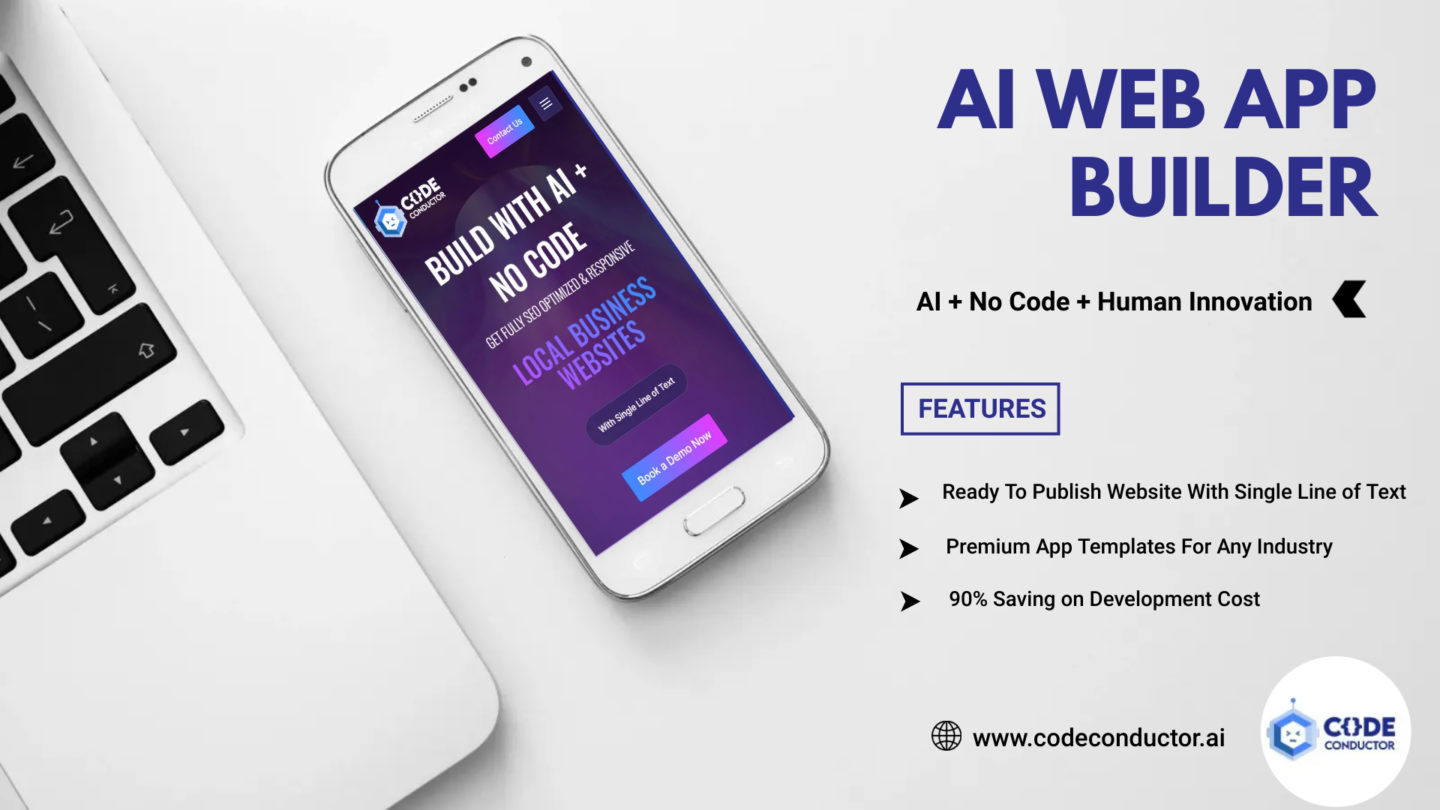
Popular website or landing page building platforms like WordPress, Squarespace, Wix, and Webflow allow users to create websites without needing to know HTML or CSS. However, they often provide templated solutions for common scenarios and limit control over application flow and design.
In contrast, Code Conductor offers complete control over complete source code via getting GitLab Access, empowering you to design and customize every aspect according to your exact preferences. You can create stunning websites, web apps, and marketplaces effortlessly, without the need for coding skills.
Conclusion
Machine learning, deep learning, and generative AI have numerous real-world applications that are revolutionizing industries and changing the way we live and work. From healthcare to finance, from autonomous vehicles to fashion design, these technologies are transforming the world as we know it. As AI continues to evolve, we can expect to see even more innovative applications that will enhance our lives and create new opportunities for businesses and individuals alike.
RedBlink, situated in Silicon Valley, is an esteemed Generative AI Development Company. Our ChatGPT developers specialize in delivering cutting-edge web and software solutions that leverage advanced generative AI applications, driving innovation and fostering growth.
Are you looking to harness the potential of Generative AI, Machine Learning, and Deep Learning? Look no further than RedBlink's Artificial Intelligence Consulting Services. With our expertise and experience, we can guide you in unlocking the true power of these cutting-edge technologies. From strategy development to implementation, RedBlink's team will support you every step of the way.
References
- "Generative AI: The Next Step in AI's Evolution" - IBM. https://www.ibm.com/blogs/watson/2020/10/generative-ai-next-step-ais-evolution/
- "Facial Recognition Technology (FERET) Program" - National Institute of Standards and Technology. https://www.nist.gov/programs-projects/face-recognition-technology-feret
- "What are deepfakes and how can you spot them?" - BBC News. https://www.bbc.com/news/technology-51285810
ChatGPT 3.5 vs. ChatGPT 4: A Comparative Analysis of AI model
ChatGPT 3.5 vs ChatGPT 4
Introduction
GPT-3, developed by OpenAI, has 175 billion parameters and has demonstrated impressive natural language understanding and generation capabilities across a wide range of tasks. As AI technology advances, there is a continuous need for improved language models that can better understand context, reason, and generate more accurate and coherent content. ChatGPT 3.5 and ChatGPT 4 represent hypothetical future iterations with enhanced capabilities, reflecting advances in NLP research and technology.
| Feature/Capability | GPT-3 | GPT-4 (hypothetical) |
|---|---|---|
| Training data | 45 terabytes of text | Significantly more data (possibly 100+ terabytes) |
| Model size | 175 billion parameters | Even larger (potentially 1 trillion+ parameters) |
| Language understanding | Advanced but with limitations | Improved understanding and context-awareness |
| Conversational depth | Limited multi-turn conversations | Better multi-turn conversations |
| Task versatility | High, can perform various tasks | Improved versatility in tasks and domains |
| Knowledge integration | Up to September 2021 | Updated knowledge with more recent information |
| Reasoning capabilities | Limited reasoning and logical thinking | Improved reasoning and logic |
| Context sensitivity | Moderate context awareness | Enhanced context sensitivity and adaptation |
| Response consistency | Inconsistent responses in long conversations | Better consistency in responses |
| Ethical considerations | Some biases, can produce unsafe content | Improved content filtering and ethical awareness |
| Energy efficiency | High computational requirements | Potential advancements in efficiency |
Please note that this table is purely speculative and based on potential improvements in natural language processing technologies. The actual features and capabilities of a hypothetical GPT-4 may differ.
https://twitter.com/OpenAI/status/1635687373060317185
Model Architecture
Both ChatGPT 3.5 and ChatGPT 4 might have a higher parameter count than GPT-3, potentially improving their understanding of complex language patterns and relationships. b. These future models could incorporate novel techniques in deep learning and NLP, improving the efficiency and effectiveness of their underlying architecture.
Training Data and Knowledge Base
ChatGPT 3.5 and ChatGPT 4 would likely be trained on more extensive and diverse datasets, allowing them to better understand various topics and contexts. Incorporating more recent data sources would enable these models to stay up-to-date with current events and recent developments. Regularly updating their knowledge bases would ensure more accurate and relevant responses.
Language Understanding and Reasoning
Both hypothetical models might exhibit improved contextual understanding, enabling them to better grasp the nuances of user input and generate more coherent replies. Enhanced reasoning capabilities could allow these models to perform tasks that require logical thinking and problem-solving more effectively. By better understanding context and user intent, these models could provide more accurate predictions and inferences.
NOTE - Don't miss out our own AI tools created using chatgpt4 API -
Rewrite AI Content To Human Written
https://redblink.com/ai-grammar-checker-content-simplifier/
Conversational Depth and Consistency
ChatGPT 3.5 and ChatGPT 4 could be better equipped to handle multi-turn conversations, maintaining context and relevance throughout extended dialogues. Improved consistency across longer conversations would result in more reliable and coherent interactions with users. Enhanced context sensitivity and adaptation could enable these models to better respond to user input in a personalized and contextually appropriate manner.
Task Versatility and Domain Adaptability
Both ChatGPT 3.5 and ChatGPT 4 might be able to perform a broader range of tasks across various domains, demonstrating increased adaptability and versatility. Task-specific outputs might be more precise and accurate, reflecting the models' improved understanding and reasoning capabilities. These models could be more effective at learning from user input, allowing them to better adapt to individual users' needs and preferences.
Ethical Considerations and Safety Measures
Addressing biases and ethical concerns is crucial, and these future models could feature improved methods for identifying and mitigating biases in their responses. Enhanced content filtering and moderation techniques might be employed to prevent the generation of harmful or inappropriate content. By incorporating safety measures, these models could reduce the potential for misuse and unintended consequences, ensuring more responsible AI deployments.
Energy Efficiency and Computation Requirements
While both hypothetical models may be larger and more complex, advances in technology and optimization techniques could lead to more energy-efficient and computationally efficient models. b. Improved energy efficiency and model optimization could make these language models more accessible and environmentally friendly.
Real-World Applications and Use Cases
Potential use cases for ChatGPT 3.5 and ChatGPT 4 might include content generation, customer support, virtual assistants, tutoring, translation, and more, with improved capabilities offering better results. Industries and sectors that could benefit from these advancements may encompass healthcare, finance, education, entertainment, marketing, and many others, as improved language models provide more accurate, coherent, and context-sensitive outputs.
Remember, this explanation is speculative, as ChatGPT 3.5 and ChatGPT 4 do not exist as of my knowledge cutoff in September 2021. The points mentioned above are based on potential advancements and improvements in the natural language processing field.
Curiosity is piqued by the astounding capabilities of ChatGPT and the array of advantages it brings. Look no further than this enlightening post called What is ChatGPT - Everything You Need to Know?
How much content can we produce in Chatgpt 4?
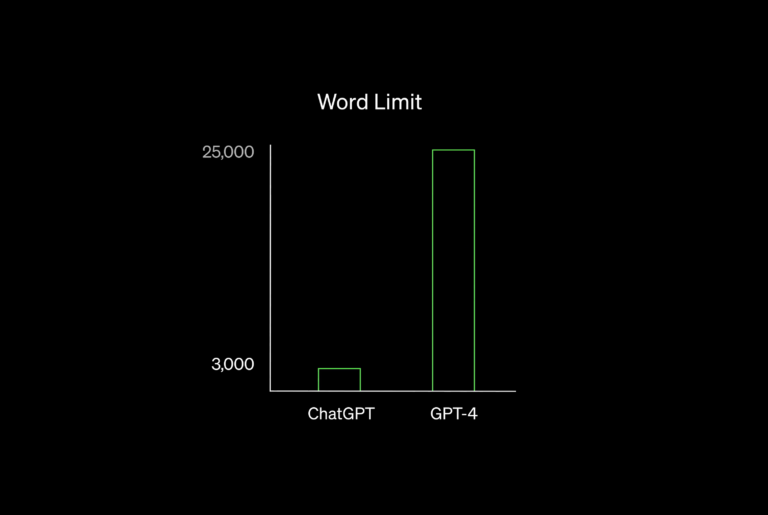
If GPT-4 were to be developed with improvements over GPT-3, it would likely be able to generate even larger amounts of high-quality content, surpassing the capabilities of GPT-3.
The quantity and quality of content produced by GPT-4 would depend on several factors, including the model size, training data, architecture, and improvements in natural language processing technologies. Given that GPT-3 is already capable of generating extensive amounts of text, a more advanced GPT-4 could potentially generate even larger volumes of content while maintaining or improving the quality, coherence, and context sensitivity.
However, without specific details on GPT-4's architecture, it is impossible to provide an accurate estimate of the content generation capabilities of a hypothetical GPT-4.
Conclusion
In summary, ChatGPT 3.5 and ChatGPT 4 represent hypothetical future iterations of language models with potential advancements in areas such as model architecture, training data, language understanding, conversational depth, task versatility, ethical considerations, and energy efficiency.
These advancements could significantly impact natural language processing, pushing the boundaries of AI's capabilities and applications.
Future developments in AI and language models promise to unlock new possibilities and opportunities, transforming the way we interact with technology and harness its potential.
A generative AI development company, Redblink has a team of ChatGPT developers ready to bring these advancements to life. Contact us today to discuss your project requirements and discover how our experts can help you leverage the power of ChatGPT.
Resources for further reading -
If you are interested in learning more about the current state of AI and natural language processing, including GPT-3, you may find these sources helpful:
- Radford, A., Narasimhan, K., Salimans, T., & Sutskever, I. (2018). Improving Language Understanding by Generative Pre-Training. OpenAI. https://s3-us-west-2.amazonaws.com/openai-assets/research-covers/language-unsupervised/language_understanding_paper.pdf
- Brown, T. B., Mann, B., Ryder, N., Subbiah, M., Kaplan, J., Dhariwal, P., ... & Amodei, D. (2020). Language Models are Few-Shot Learners. OpenAI. https://arxiv.org/abs/2005.14165
- OpenAI. (2020). Introducing OpenAI’s GPT-3. https://www.openai.com/blog/openai-api/
- Bender, E. M., Gebru, T., McMillan-Major, A., & Shmitchell, S. (2021). On the Dangers of Stochastic Parrots: Can Language Models Be Too Big? https://faculty.washington.edu/ebender/papers/Stochastic_Parrots.pdf
These sources discuss the development and capabilities of GPT-3 and touch on the challenges and limitations of large-scale language models. They provide insight into the current state of AI research and may help inform your understanding of potential future advancements. However, they do not specifically discuss ChatGPT 3.5 or ChatGPT 4, as these versions are hypothetical and not based on real-world developments.
HIPAA Compliance Checklist for Mobile App Development [2024]
HIPAA Compliance Checklist for Mobile App Development [2024]
"Mobile health apps are revolutionizing the healthcare industry," says Karen DeSalvo, former National Coordinator for Health Information Technology at the U.S. Department of Health and Human Services.
However, with the increasing demand for healthcare apps, healthcare service providers must prioritize HIPAA-compliant mobile app development to protect patient data.

To ensure a better understanding of HIPAA compliance guidelines, it's important for healthcare service providers to familiarize themselves with the requirements before diving into the world of mobile healthcare apps.
That's where the HIPAA-Compliant Checklist for Mobile App Development 2024 comes in, outlining the essential steps needed to create apps that prioritize patient privacy and security.
So, let's take a closer look at this checklist and see how healthcare service providers can develop HIPAA-compliant apps that meet the highest standards of privacy and security.
Importance of HIPAA Compliance in Mobile App Development
Did you know that according to a survey conducted by the Pew Research Center, around 60% of Americans have used mobile health apps to monitor their health or access health-related information? This highlights the growing importance and popularity of mobile health apps in the healthcare industry.
Health Insurance Portability and Accountability Act(1996 - 2013 revised), is a set of regulations to guarantee the confidentiality and security of sensitive patient data across various healthcare applications
Most of the healthcare apps related to medical data are as per the compliance standards. Developing a compliant mobile app is easy. Healthcare software developers straight away follow these rules such as:
you can ensure that patient data remains secure and confidential. These rules explain the steps that healthcare providers must follow to keep patient information safe.
In case you violate the compliance rules and standards, the OCR (Office for Civil Rights) in the U.S. Department of Health and Human Services (HHS) will investigate the issue. They are also a great source of information for anything related to HIPAA compliance.
By following the above-mentioned rules, you can develop a healthcare mobile application that ensures a secure and reliable medical business, while also safeguarding the privacy and confidentiality of patient data.
Which Healthcare Apps Should Comply With HIPAA rules?
Any healthcare app listed in Google Play Store or Apple App Store that deals with the data collection, storage, and transmission of protected health information (PHI) is required to comply with HIPAA rules. This includes healthcare apps that allow users to schedule appointments, access medical records, communicate with healthcare providers, track their health and fitness, or receive medical advice or treatment.
Here are the types of medical mobile apps that are HIPAA Compliant:
-
Telemedicine Apps
Telemedicine apps allow healthcare providers to conduct remote consultations with patients, making healthcare more accessible and convenient.
Examples of compliant telemedicine apps are : Teladoc, MDLive, and Amwell.
-
Electronic Health Records (EHR) Apps
EHR apps allow patients to access their medical records, view lab results and manage their health information.
Examples of compliant EHR apps are : Epic MyChart, Cerner, and Athenahealth.
-
Patient Portals
PP apps allow patients to communicate with their healthcare providers, schedule appointments and request prescription refills.
Examples of compliant patient portals apps are:: FollowMyHealth, MyChart, and Healow.
-
Medical Device Apps
Device apps are designed to work with medical devices to track health data and monitor health conditions. WordPress-based websites
Examples of compliant medical device apps are : Dexcom G6, Medtronic CareLink, and Omron Connect.
Overall, mobile app developers opt to develop apps that support WordPress-based websites ensuring web integration. Apart from this, an app following healthcare regulations must implement AES and RSA algorithms to ensure the security and privacy of data.
mHealth and HIPAA Compliant Apps for consumers
mHealth (mobile health) apps are mobile applications that provide health-related services or information through mobile devices such as smartphones or tablets. These apps are designed to help people manage their health and fitness.
All health apps must have privacy policies. If an app follows the privacy rules and takes responsibility for sharing a patient's information, it is called a HIPAA-compliant app. Otherwise, it's just a regular mHealth app that tracks data such as calories burned, total step count, or distance covered and provides health services.
Some examples of mhealth apps are- MyFitnessPal, Headspace, 7 Minute Workout, Clue, Medisafe, etc. All these apps are either fitness, sleep monitoring or health rate monitoring apps.
For a better understanding, let's take a closer look at health application cases that use covered entities (patient name, address, contact information, disease, remedies, medicine, etc.)
Examples of use cases
It is important to note that any health app that misuses customer data for commercial use is not compliant with HIPAA regulations. One use case scenario of such a violation could be an app designed for remote patient monitoring. The app collects data on patient health habits and behaviors.
If the app were to sell or share this information with third-party companies for targeted advertising or other commercial purposes, it would violate HIPAA regulations and compromise the privacy of the app's users. This type of misuse of customer data could result in legal and financial consequences for the app developer and could also harm the reputation of the healthcare service provider associated with the app.
mHealth HIPAA Compliant Apps for Healthcare Service Providers
HIPAA compliance is not only important from the consumer's point of view but also crucial for healthcare service providers. Covered entities, which include healthcare providers, health plans, and health clearinghouses, must comply with standard regulations to protect patient's privacy and ensure the security of their health information.
Failure to comply with regulations can lead to costly fines, lawsuits, and damage to the healthcare provider's reputation. Therefore, it is essential for healthcare service providers to choose software that aligns with standard regulations with HITECH demands.
HIPAA-compliant mHealth apps must have specific security measures in place to protect patients' Protected Health Information (PHI), such as data encryption, user authentication, and regular security risk assessments. Using multimodal biometric authentication technology is the latest trend in designing a compliant app with a single sign-on (SSO).
By ensuring that their software and apps are HIPAA compliant, healthcare service providers can not only protect their patients' privacy but also demonstrate their commitment to providing high-quality care.
Examples of use cases
The example will help you understand the requirement of compliant apps from the healthcare service provider's perspective.
Let's take the example of a hospital that wants to implement a new patient portal app. The app will allow patients to access their medical records, communicate about their bills, and schedule doctor appointments. The hospital is designing a HIPAA complaint app to handle PHI such as medical history, lab results, and prescriptions.
The hospital must hire a team of mobile app developers that understands HIPAA regulations. The app should be designed with HIPAA standards to protect patient data. Privacy violations can lead to the misuse of patients’ data and records.
Also, the same thing applies to the billing firm of the hospital that handles the hospital's payments must also comply with HIPAA regulations since they will have access to patient data. Overall, any party involved in the development, deployment, and maintenance of the patient portal app must comply with HIPAA standards to protect the privacy and security of patient information.
Further, the key considerations while developing a HIPAA app will simplify the development process.
Key Considerations for HIPAA-Compliant Mobile App Development
By considering the key factors, a featured app can be designed. Mobile app developers and organizations must ensure that the app meets the necessary standards. The app must access patients' records as per PHI rules. To design an app following HIPAA rules, here are some of the considerations:
-
User authentication and access control
Developers need to implement strong user authentication mechanisms, such as passwords or biometrics, to ensure that only authorized users can access PHI. Access control mechanisms, such as role-based access control (RBAC), should also be implemented to ensure that users have access only to the PHI that they need to perform their job functions.
-
Data encryption and transmission security
PHI needs to be encrypted both when it is stored and when it is transmitted. Encryption helps to protect PHI from unauthorized access and ensure that it cannot be read or intercepted by unauthorized parties. Developers should also implement secure data transmission protocols, such as HTTPS, to ensure that PHI is transmitted securely.
-
Data storage and disposal policies
Developers and organizations need to have policies in place for the storage and disposal of PHI. PHI should be stored securely and for only as long as necessary, and disposed of securely when it is no longer needed. Policies should also be in place for the destruction of electronic devices, such as smartphones or tablets, that have stored PHI.
-
HIPAA-compliant third-party integration
Developers need to ensure that any third-party services or vendors that are used in the mobile app development process are also HIPAA compliant. This includes ensuring that business associate agreements (BAAs) are in place and that the third-party services or vendors are implementing appropriate safeguards for the handling of PHI.
HIPAA Compliant Mobile App Development Checklist

A checklist for healthcare mobile app development serves as a useful tool to identify any possible risks or vulnerabilities that could pose a threat to the security of Protected Health Information (PHI). To ensure compliance standards, follow these step-by-step guidelines:
-
Measuring risk analysis
Explore the risks involved by identifying vulnerabilities associated with PHI. This analysis should include a thorough evaluation of your app's features and functionalities, as well as an assessment of your app's data storage and transmission practices.
-
Design your app with HIPAA in mind:
It is important to keep the security rules in mind. To protect patients’ records and medical data, techniques such as data encryption, access control, and secure data transmission must be used.
-
Incorporating security measures
To avoid unauthorized access of data on a medical website, make sure that the app is having password protection, user authentication, and audit trails. Also, the app must have a privacy agreement for users to prevent data from leakage.
-
Develop a privacy policy
Develop a clear and concise privacy policy that outlines how your app handles PHI. The policy should inform users of their rights under HIPAA, as well as provide details about how their data is collected, stored, and shared.
-
Train your employees
Train your employees on HIPAA regulations, including the importance of data security and privacy. Ensure that all employees who have access to PHI are aware of their responsibilities and obligations under HIPAA.
-
Conduct regular audits
Conduct regular audits to ensure that your app remains compliant with HIPAA regulations. This includes testing your app's security and privacy features, as well as reviewing your app's data storage and transmission practices.
-
Use a HIPAA-compliant hosting service
Use a hosting service that is HIPAA-compliant to ensure that your app's data is stored and transmitted securely. HIPAA hosting providers add firewall security to ensure secure storage.
-
Sign a business associate agreement (BAA)
If you are a developer creating an app for a healthcare organization, sign a business associate agreement (BAA) with the organization. This agreement outlines the responsibilities and obligations of both parties under HIPAA.
By following these steps, you can ensure that your mobile app is HIPAA compliant and meets the necessary security and privacy standards for handling PHI.
RedBlink – One Stop Solution for developing a HIPAA-Compliant Mobile App Development!
In conclusion, developing a mobile complaint app is crucial for protecting sensitive health information and complying with regulations. By using a mobile app development checklist and following HIPAA Compliant best practices, organizations can ensure that their apps meet the necessary standards for protecting PHI.
At RedBlink, we have an expert team for Android App Development and iPhone App development. They are aware of the sensitivity involved in storing and using patient data. Keeping the rules and regulations in mind, we design the most secure and compliant mobile apps using advanced mobile app development tools. We use a comprehensive range of security features, including data encryption, access controls, and data protection policies, all designed to ensure that your app meets HIPAA requirements.
So if you're looking to develop a mobile app that is HIPAA-compliant, secure, and reliable, - choose RedBlink for your next mobile app development project. You can approach us to discuss new mobile app development ideas. Developing a secure app meeting all the security standards is our guarantee to our clients.
RedBlink is a leading healthcare website design agency that specializes in developing HIPAA-compliant mobile apps and websites for pharmacies, plastic surgeons, ophthalmologists, and other healthcare professionals.
HIPAA Compliance Website Checklist [Specs, Rules, Guide 2024]
HIPAA Compliance Website Checklist
The healthcare industry is heavily regulated, and for that reason, healthcare websites are designed as per HIPAA compliance. Healthcare Insurance Portability and Accountability Act (HIPAA) compliance is a US federal law enacted in 1996 to establish national standards for the protection of individuals' medical records and personal health information.
According to the Department of Health and Human Services (US), as of January 2022, there have been over 3,400 reported HIPAA breaches affecting 500 or more individuals since 2009. The fact highlights the critical importance of HIPAA-compliant website design to protect sensitive patient information.
As a healthcare service provider, you would like to design a website to deliver the best service. To make this process easier for you, we've put together a comprehensive HIPAA compliance checklist that will help you design a user-friendly and HIPAA-compliant website.
 How to Develop a HIPAA-Compliant Healthcare Website?
How to Develop a HIPAA-Compliant Healthcare Website?
So, if you are planning to launch or design a HIPAA-compliant website, the first step is to choose a web hosting company that specializes in HIPAA-Compliant web hosting. The hosting service provider must have web server must comply with the physical, technical, and administrative safeguards of HIPAA
Before you plan further, let’s learn more about the technical specifications and Data related policies to design a HIPAA website.
 Technical Specifications to Design HIPAA websites
Technical Specifications to Design HIPAA websites
A robust HIPAA-compliant website is a highly secured website. Here are specific technical specifications for designing websites following HIPAA rules:
- Use Secure Socket Layer (SSL)-Encryption/decryption techniques
- Password-protected login form with authority restrictions
- Secure database software for data management
- Maintain audit logs to track access to PHI
- Implementing the latest website development techniques to handle data integration
Above all, include the HIPAA entities in web pages like:
| A Health Care Provider | A Health Plan | A Health Care Clearinghouse |
This includes providers such as:
...but only if they transmit any information in an electronic form in connection with a transaction for which HHS has adopted a standard. |
This includes:
|
This includes entities that process nonstandard health information they receive from another entity into a standard (i.e., standard electronic format or data content), or vice versa. |
By following these technical specifications, you can design a HIPAA-compliant website that protects patients' confidential health information and maintains the highest standards of security and care.
Data Usage, Sharing, and Storage Policy
You can take several steps to ensure that your website is HIPAA compliant. And all the efforts stem from data security. If your data isn’t secure, it doesn’t matter if you comply with every other guideline in HIPAA. So, you must take decisive steps to guard PHI against accidental breaches.
Protected health information (PHI) and electronically protected health information (ePHI) refer to any identifiable data about the patient, including :
- name,
- address,
- date of birth,
- SSN (social security number),
- device identifiers,
- email addresses,
- biometrics,
- lab or imaging results,
- medical history,
- payment information.
So, the data displayed through web pages must be in accord with PHI.
HIPAA Compliance Rules
HIPAA Compliance Rules are a set of regulations for healthcare organizations and their business associates. The compliance rules are to protect the privacy, security, and confidentiality of patients' health information following PHI rules.
 HIPAA Privacy Rule
HIPAA Privacy Rule
The Privacy Rule sets standards for protecting PHI, including who can access it, how it can be used, and when it can be disclosed. It also gives patients the right to access and control their PHI. Privacy rule is the specific standard within HIPAA Law to establish national standards on how covered entities, health care clearinghouses, and business associates share and store PHI. The established privacy rules protect patients’ information used during health care services.
 HIPAA Security Rule
HIPAA Security Rule
The Security Rule under HIPAA outlines the standards, procedures, and methods for safeguarding electronic PHI during storage, accessibility, and transmission. It comprises three levels of safeguarding:
Administrative: Administrative safeguards involve appointing a HIPAA security compliance team.,
Technical:, Technical safeguards include encryption and authentication methods to control data access, and
Physical. Physical safeguards ensure the protection of electronic systems, data, and equipment in your facility.
Administrative safeguards involve appointing a HIPAA security compliance team. Technical safeguards include encryption and authentication methods to control data access, while Physical safeguards ensure the protection of electronic systems, data, and equipment in your facility.
Additionally, this rule also includes risk analysis and management protocols for hardware, software, and transmission.
HIPAA Enforcement Rule
The HIPAA enforcement rules cover the consequences of violations committed by business associates or covered entities, focusing on five key areas. These areas include enforcing HIPAA privacy and security rules, mandating security breach reporting, accounting disclosure requirements, restrictions on marketing and sales, and limitations on business associate or covered entity contracts. The rule was derived from the ARRA HITECH ACT provision and applies to violations before or after the February 18, 2015 compliance date, expanding the scope of HIPAA Privacy and Security rules and imposing higher penalties for any violations.
Breach Notification Rule
The Breach Notification Rule requires covered entities to notify patients and the Department of Health and Human Services (HHS) of any breach of unsecured PHI that compromises the privacy or security of patients' information.
Omnibus Rule
The Omnibus Rule updated HIPAA regulations to include business associates and subcontractors who handle PHI on behalf of covered entities. It also strengthened patients' rights to access and control their PHI.
Failure to comply with HIPAA regulations can result in significant financial penalties, legal liability, and damage to an organization's reputation. Therefore, it is essential for healthcare organizations and website development companies to understand and follow these rules.
10 Step checklist for designing a HIPAA-compliant healthcare website
Now that you understand the importance of designing a HIPAA-compliant healthcare website, let's take a look at a 10-step checklist to ensure that your website meets all the requirements.
1️⃣ Determine if HIPAA Is Necessary
HIPAA-compliant website design can be a costly affair, but it is necessary for any website that collects and uses patients' personal health information, such as an online patient portal.
For example, a telemedicine platform that allows patients to consult with doctors online and provides them access to their medical records would require HIPAA compliance.
However, if you are a general health care service provider that only uses third-party compiled data and does not collect patients' personal health information directly on your website, then you may not need your website to be HIPAA-compliant.
2️⃣ Research Healthcare Industry Needs
HIPAA regulations go beyond safeguarding patient data; it also mandates monitoring access to information. Covered entities must keep a record of who has viewed PHI, the reason for accessing it, what information was accessed, and if any data was transferred. It's essential to partner with a healthcare website design company having complete knowledge of designing medical service based websites with HIPAA integration.
For example, suppose a healthcare organization uses an eCommerce platform to sell medical devices to patients. In that case, they must ensure that the platform complies with HIPAA regulations to protect confidential information during transactions. The eCommerce platform must have proper access controls, audit trails, and secure data transfer mechanisms to provide secure transactions.
3️⃣ Learn HIPAA Website Basics
To ensure your healthcare website complies with HIPAA regulations, you must adhere to the following requirements:
- Implement appropriate safeguards and rules to protect patient health information from unauthorized access or disclosure.
- Restrict the sharing of confidential data to authorized stakeholders who are directly involved in patient care.
- Ensure any third-party business associates or corporate partners who handle PHI follow HIPAA regulations and only share information in the patient's best interests.
- Control access to PHI and train employees on security and confidentiality best practices to maintain privacy and prevent data breaches.
For example, a hospital website must ensure that patient information is safeguarded and only accessible to people who need it. The website should also ensure that any third-party service providers, such as IT companies, comply with HIPAA regulations and handle the data following PHI rules. Additionally, the website should have access controls, audit trails, and regular employee training on data security and confidentiality best practices.
4️⃣ Encrypt HIPAA Compliant Patient Intake Forms
Web forms are used to collect various types of information from patients or clients, including medical and health insurance data. To ensure the security of this sensitive information, it's crucial to use HIPAA-compliant web forms that encrypt the connection between the browser and the website. This prevents unauthorized access to the data entered on the website or forms.
It's essential to choose a reliable hosting provider with experience in transferring forms to the HIPAA web server to ensure compliance with the regulations.
For instance, a healthcare provider's website can use HIPAA-compliant web forms to collect patient information such as medical history, allergies, and medications. This information is then stored securely and used to create centralized and long-term medical records. This info can be misused by corporates
Checkout list of best HIPAA Compliant Form Builders for Customized Online Forms
5️⃣ Use HIPAA Compliant Contact Forms
A contact form on a healthcare website can be any page that enables patients to submit information, such as pre-visit health surveys, patient portals, and live chat facilities. It's crucial to ensure the security of these forms, as patients may provide sensitive information related to their health conditions.
For example, a patient portal allows patients to communicate with their doctors allowing them to share their medical records. Here a contact form is used to share information that encrypt the data entered by patients and restrict access to authorized personnel only.
6️⃣ HIPAA Compliant Web Servers
HIPAA regulations require that PHI be protected at every step. This includes secure protection for PHI when stored in the Cloud and during any internet transfer. To ensure HIPAA compliance, follow these steps:
Collecting PHI: If your website collects any individually identifiable medical information, such as symptoms, conditions, or requested healthcare services, you are collecting PHI. That information must be securely transmitted to the web server.
Storing PHI: Whether you store the PHI on your own server or on a third-party server, you must ensure that the security of the information is HIPAA compliant and that regular maintenance is done to keep it secure.
Transmitting PHI: PHI must be secure and encrypted when it is transferred in any way. This includes direct transfer between servers, via email, or any other digital transference. End-to-end encryption must be used for any information sent back and forth between healthcare providers.
7️⃣ Install a Robust SSL Certificate
SSL protection is a networking protocol that provides client and server authentication and encrypted communication between the two. It ensures that all information entered or managed on a website, including login credentials and account details, is safely encrypted at all times. This means that if any unauthorized access or interception of information occurs, the information will be unreadable and unusable. Installing SSL on a website allows your website to be in HIPAA compliance.
Checkout the best SSL Certificate Services To Buy From In 2024
8️⃣ Finding a Hosting Provider aware of HIPAA restrictions
HIPAA-compliant hosting is essential to protect personal health information (PHI) and is the first line of defense against data breaches. A reputable HIPAA-compliant host offers several security measures to ensure that the data is safe and secure. This includes periodic vulnerability scans of servers, encryption of data in transit and storage, server hardening, offsite backups, and log retention for a minimum of six years.
All as a healthcare business owner , you need to book your website domain with a hosting service provider working with HIPAA compliance.
9️⃣ The website must follow Business Associate Agreement
If your vendors have access to your PHI, it is essential to have a signed Business Associate Agreement (BAA) to comply with HIPAA guidelines and protect your business from liability. However, you are still responsible for ensuring your business associates have the necessary safeguards to protect PHI.
It's best to conduct a website audit and request risk assessments, and evidence to ensure the security of your PHI. The following vendors will require a BAA.
- Hosting providers
- cloud storage providers
- IT vendors
- digital marketing firms
- e-prescribing software vendors
- billing software vendors
- file sharing vendors
- medical answering services
- email encryption services
- translator services
? Choosing The right HIPAA Compliant Solution
Choosing the right HIPAA-compliant solution for your business requires careful consideration of several factors. Look for a healthcare website design agency like RedBlink Technologies which offers offering secure hosting, regular vulnerability scans, and data encryption in transit and at rest. Also, ensure that website designers have prior experience in designing healthcare websites.
Consider the specific needs, such as the need for electronic medical record (EMR) integration, secure messaging, or patient portal access.
Choosing custom website design services with experience in developing a HIPAA-compliant website will save you time and money. You won't need to spend time explaining HIPAA compliance to the agency
RedBlink - Your One-Stop Solution for HIPAA Compliant Website Development
In conclusion,designing a HIPAA-compliant website is not just about meeting regulatory requirements, it's about protecting your patients' sensitive information and maintaining their trust in your organization. With secure technology solutions, proper training for staff, and regular risk assessments, healthcare organizations can minimize the risk of data breaches and avoid potential legal and financial consequences.
If you're looking to design a website that is compliant with HIPAA regulations, you can trust RedBlink's HIPAA Compliant Website Design and Development Services!
Our team of experts is dedicated to ensuring your website is secure, up-to-date, and fully compliant with HIPAA regulations. By following the comprehensive HIPAA Compaince checklist for 2024, we can design a website that meets all of your needs while prioritizing the privacy and security of your patients' data.
Contact us today to learn more about how we can help you create a website that is both user-friendly and HIPAA-compliant. Trust us to help you build patient trust and avoid potential legal and financial consequences.
Redblink is a leading healthcare website design agency that specializes in developing HIPAA-compliant mobile apps and websites for dermatologists, veterinary, orthopedists, and other healthcare professionals.
11 Best AI and ChatGPT Content Detectors Comparison in 2024
AI Content Detector Tools
According to Forbes, BuzzFeed’s stock surged to a seven-month high as the online media company vowed to invest heavily in artificial intelligence-driven content.
As the above stat says, in the world of digital content creation, quality content is crucial for standing out from the crowd and attracting a loyal audience. With the ever-increasing volume of content being created, it can be challenging to ensure that your content is original, high-quality, and free from plagiarism.
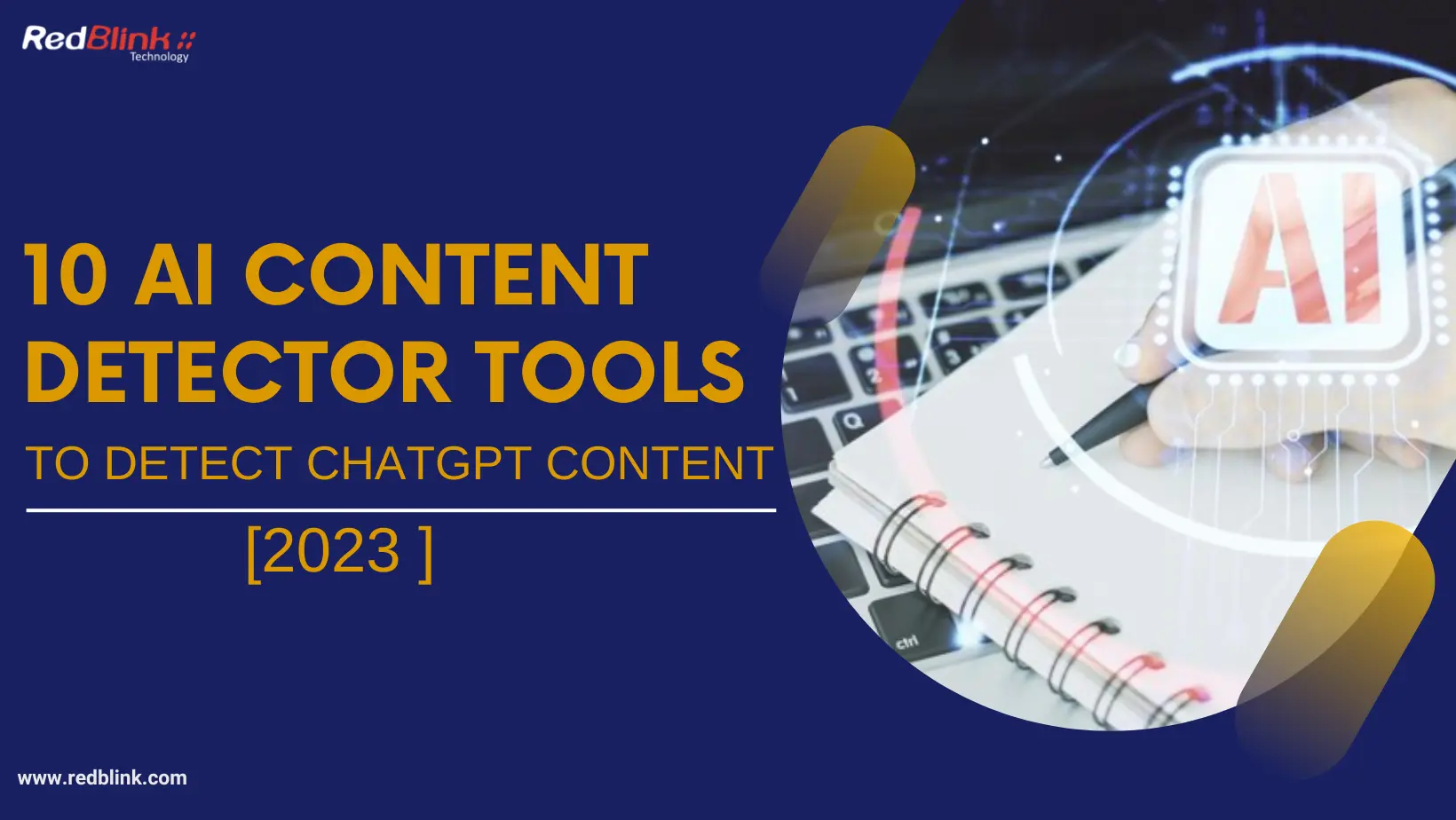
That's where AI content detection tools come into play. These tools use machine learning algorithms to analyze text and identify instances of plagiarism or duplicate content, thereby helping to improve the overall quality of your work.
As we move into 2024, the importance of AI content detection tools has increased. According to Google Trends, the term "AI content detector” has seen a breakout in searches in recent years, indicating a growing interest in these tools.
Some popular keywords related to AI content detector tools that have become popular since the launch of Open AI ChatGPT include GPT-3 Detector, AI Text Detector, AI Writing Detector, GPT Detector, Chat GPT Detector, and AI Content Checker.
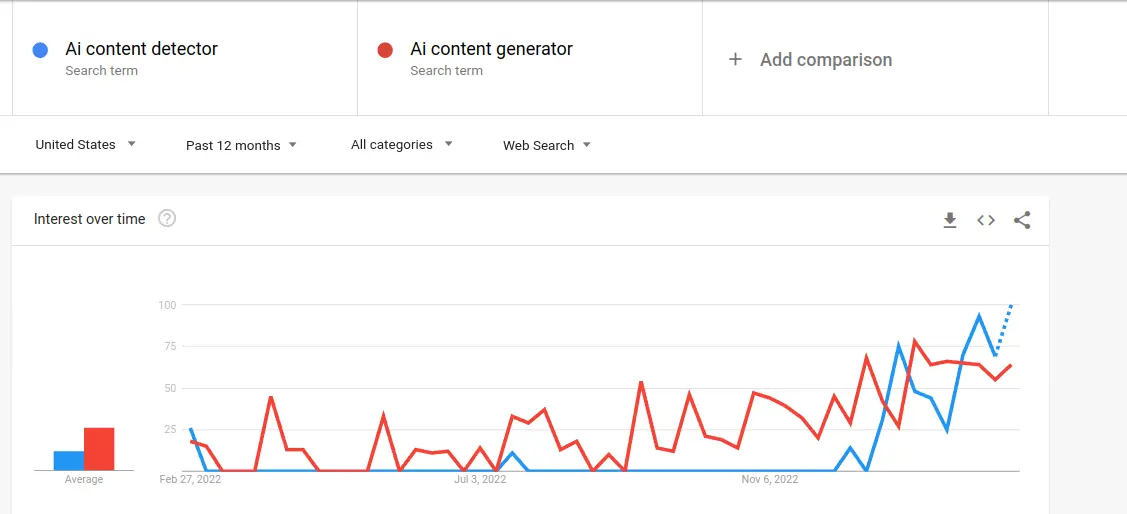
The above graph from Google Trends clearly shows that “AI Content Detector” is getting more concerned than “AI Content generator" tools.
With so many options available, it can be difficult to know which tools to choose. That's why we've compiled a list of the top 10 AI content detector tools to help you detect AI content and content monitoring.
From advanced plagiarism checkers to content optimization tools, these tools are designed to streamline your content creation process and ensure that your content provides relevant information
Let's dive into our list of top 10 AI Content detection tools.
What are the AI Content Detector Tools?
AI content detector tools refer to software applications that use artificial intelligence (AI) algorithms to analyze written text and detect potential issues such as plagiarism, grammar errors, or inappropriate content.
These tools use various AI techniques, including natural language processing (NLP), machine learning, and deep learning. They help to understand the meaning and context of written content and identify any potential issues.
If you're curious about the incredible capabilities of ChatGPT and the benefits it brings, you should definitely check out this informative post on "What is ChatGPT and Its Benefits"?
Once you've grasped the potential of AI in content creation, you might be interested in discovering the top AI content detector tools available. Look no further than this handy article on RedBlink: "Top AI Content Detector Tools: Ensuring Authenticity and Accuracy" (link: https://redblink.com/top-ai-content-detector-tools/).
Why are AI Content Detectors important for Business Websites?
AI content detector tools are important for business websites for several reasons:
- Ensuring quality and accuracy of content: AI content detector tools can help businesses ensure that their written content is free from errors and meets high standards of quality. This can be particularly important for businesses that rely on written communication to convey important information to customers or stakeholders.
- Protecting intellectual property: AI content detector tools can help businesses detect instances of plagiarism or copyright infringement, which can be detrimental to their reputation and legal standing.
- Saving time and resources: Manually checking written content for errors and issues can be time-consuming and labor-intensive. AI content detector tools can automate this process, saving businesses time and resources that can be used for other tasks.
- Improving search engine optimization (SEO): AI content detector tools can help businesses optimize their written content for search engines, ensuring that it appears higher in search results and reaches a wider audience.
- Maintaining brand image and reputation: Inappropriate or offensive language in written content can damage a business's brand image and reputation. AI content detector tools can help businesses identify and remove such language, ensuring that their written content is suitable for all audiences.
Overall, AI content detector tools can help businesses improve the quality and effectiveness of their written communication, protect their intellectual property, and maintain a positive brand image and reputation.
NOTE - Dont miss out our own AI tools created using chatgpt4 API -
Bypass AI detection - FREE Tool to Convert AI Content To Human Written
https://redblink.com/ai-grammar-checker-content-simplifier/
Top AI Content Detectors Compared & Tested
1. GPTZero - Efficient detection of AI-generated text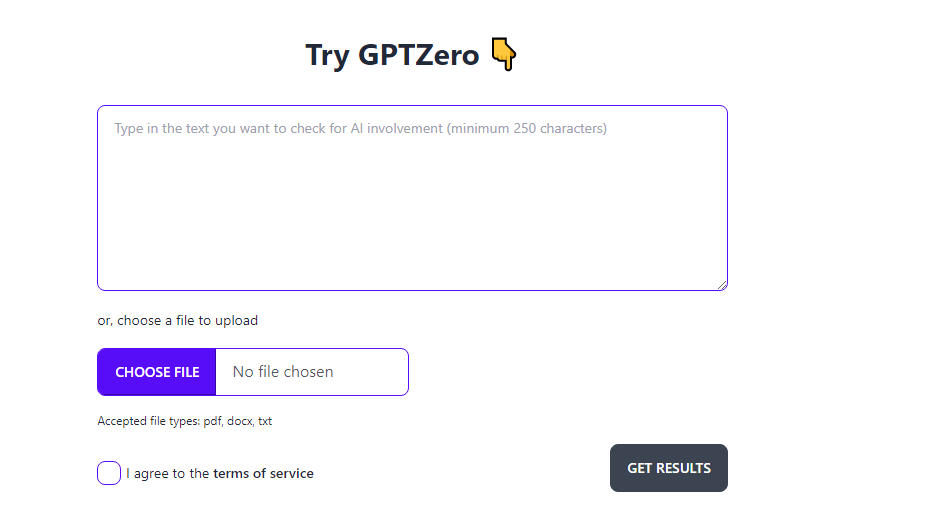
Here is an example of A Princeton student created GPTZero for teachers to detect AI plagiarism
( Efficient detection of AI-generated text )
It measures total text perplexity:
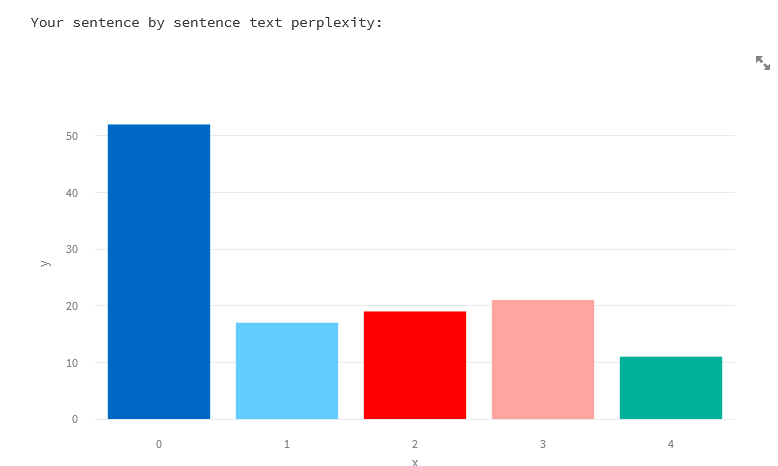
Perplexity — ie. the randomness of the text is — a measurement of how well a language model like ChatGPT can predict a sample text.
simply put, it measures how much the computer model likes the text.
your text perplexity evaluated on gpt2 (345M parameters) is 10 which is comparatively low. texts with lower perplexities are more likely to be generated by language models
Measures average sentence perplexity:
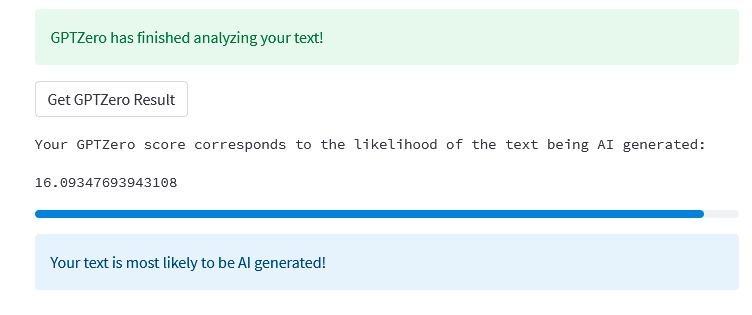
Perplexity itself is an incomplete indicator that misses many factors including
text length. longer texts are less random and generally have lower perplexities
Your average perplexity (across sentences), a better indicator that considers text length, is 24.0
2. AI and Plagiarism Checker - Originality
Hey there, are you a serious web publisher looking for a top-notch plagiarism-checking and AI detection tool? Look no further than Originality.AI! Unlike other tools that are built for academia, Originality.AI is specifically designed with your needs in mind.
Our team of content marketing and GPT-3 AI experts understand that you need more than just a basic plagiarism checker. That's why we offer unique features like Team Management, Full Site Scan (coming soon), Auto-Billing, Scan History by User, and most importantly, an AI Writing Detection tool.
Using our state-of-the-art AI Content Detector and modern Plagiarism Checker, you can be sure that your content is 100% original. Our tool is capable of detecting even GPT-3 and ChatGPT-generated content, making it the most accurate AI Detector on the market.
If you're using AI Content, Originality.AI is a game-changer for your business. Don't settle for less - try Originality.AI today and see the difference it can make for your website!
Key Features:
- Identifies plagiarism quickly and efficiently
- Ensures originality in academic and professional settings
- Uses advanced NLP algorithms to analyze text
- Cross-checks text with a user-defined database of sources
- Helps users learn proper citation and referencing practices
3. Free WP plugin that detects fluff & AI-written content - Unfluff
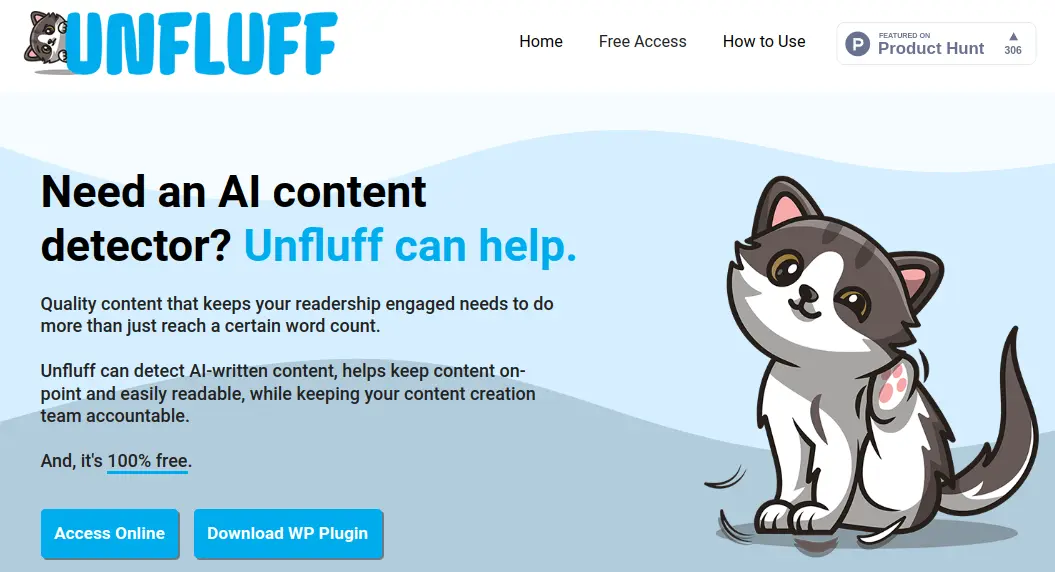
You don't want useless information on your website, especially if you want it to rank on Google. Fluff, or filler content, is bad for readership and can ruin your search rankings.
Some content writers use AI tools to add unnecessary content just to increase word count. But Google knows better and is fighting against these tools. AI content can harm readability and bounce rates, which can hurt search engine rankings.
Want to detect AI content? Unfluff can help. It detects filler and AI-written content, and helps keep your content on-point and easy to read. It's also free!
Unfluff is a free tool that works with WordPress. It detects filler and AI-written content, and helps keep your content team accountable.
Key Features:
- Fast and Efficient: Unfluff AI can quickly detect fluff content, saving valuable time for content creators and editors.
- Customizable Settings: The tool allows users to set their own parameters for what constitutes fluff content, tailoring the detector to their specific needs.
- Multiple File Formats: Unfluff AI can analyze various file formats, including HTML, PDF, and plain text.
- Multi-language Support: The content detector can analyze content written in different languages, making it useful for international users.
- API Access: Unfluff AI also provides API access, allowing developers to integrate the content detector into their own applications.
4. AI Content Detector - Copyleaks
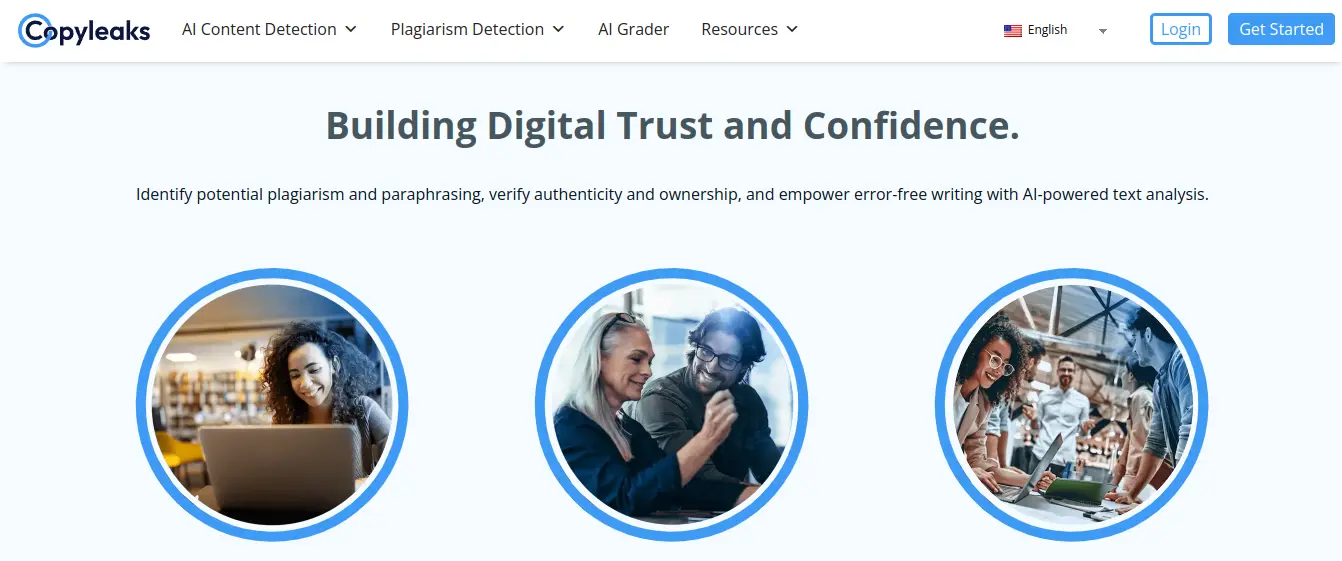
In today's world, it's more important than ever to know if content is real or created by AI. Whether you're browsing the internet, creating content, or grading papers, you need to be sure of what you're reading.
Enter AI Content Detector, the only enterprise AI-content detection solution available! With 99% accuracy and the ability to integrate with LMS and API, this is the most comprehensive and accurate AI text detection solution available anywhere!
Want to take it to the next level? Check out Copyleaks AI Content Detector API! With an incredible 99.12% accuracy, it's the only enterprise platform designed to detect whether content was written by a human or AI, including ChatGPT, in multiple languages such as English, French, Spanish, German, and Portuguese. Plus, it's fully customizable to meet the needs of your team and organization.
Developers, listen up! The AI Content Detector API was created with you in mind. It supports most programming languages, including C#, Node.JS, PHP, Java, Ruby, Python, and more. So, what are you waiting for? Start exploring AI Content Detector API today and add a new level of content protection and verification to your work!
Key Features:
- Multiple File Formats: Copyleaks supports various file formats, including Word, PDF, TXT, HTML, and more, making it easy to scan and detect copied content from different file types.
- Multilingual Support: Copyleaks supports over 100 languages, making it easy for users to detect plagiarism in different languages
- API Integration: Copyleaks offers an API that allows developers to integrate Copyleaks’ plagiarism detection capabilities into their own applications and workflows.
- User-Friendly Interface: Copyleaks’ user-friendly interface makes it easy to upload and scan documents, view results, and generate reports.
5. AI Content Detector / GPT-3 / ChatGPT - Writer
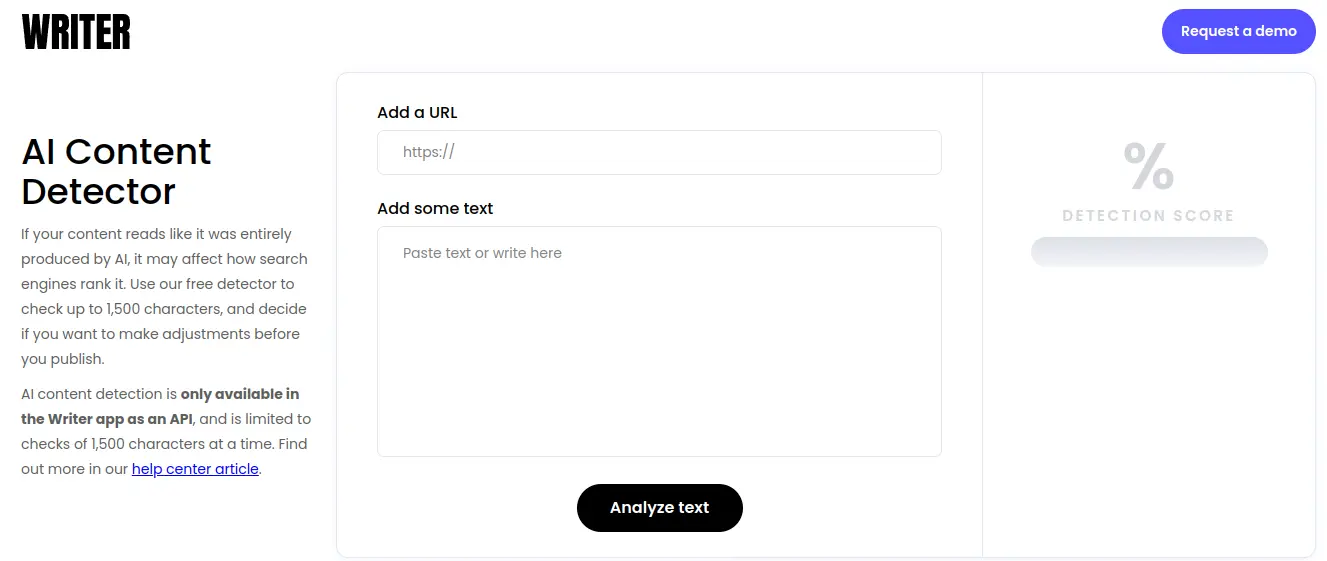
If your writing seems like it was entirely created by a machine, it could impact how search engines rate it. You can use our free detector to examine up to 1,500 characters of your content, and determine if you need to make modifications before publishing.
The AI content detector is accessible solely via the Writer app as an API, and it is restricted to inspecting 1,500 characters at a time.
If you're a developer seeking to incorporate the AI detector into an application, utilize the API. For Team plan members, the AI detector may inspect up to 500,000 words each month through the API. The AI content detector is the sole API endpoint accessible on a Team plan.
Enterprise plans have greater allowances and complete access to the API. If you're interested in detecting machine-generated content at scale, contact the sales team to learn more.
The AI content detector examines whether the supplied text is likely to follow the same word pattern as a big language model, given a query or input. Even if someone writes using very similar word sequences, their writing may activate the detector. The detector won't be completely precise, but it may help give an idea of the likelihood that something was generated by a machine.
Key Features:
- NLP technology detects and creates unique content for brands
- Free up to 1500 characters
- Creates different types of content quickly such as social media copy, articles, emails, etc.
- Efficiently checks large amounts of text for plagiarism
- Provides suggestions for citations and referencing
- Available as an extension for Chrome, Word, Edge, Docs, etc.
6. Free AI Content Detector Tool (GPT-3 and ChatGPT) - Sapling
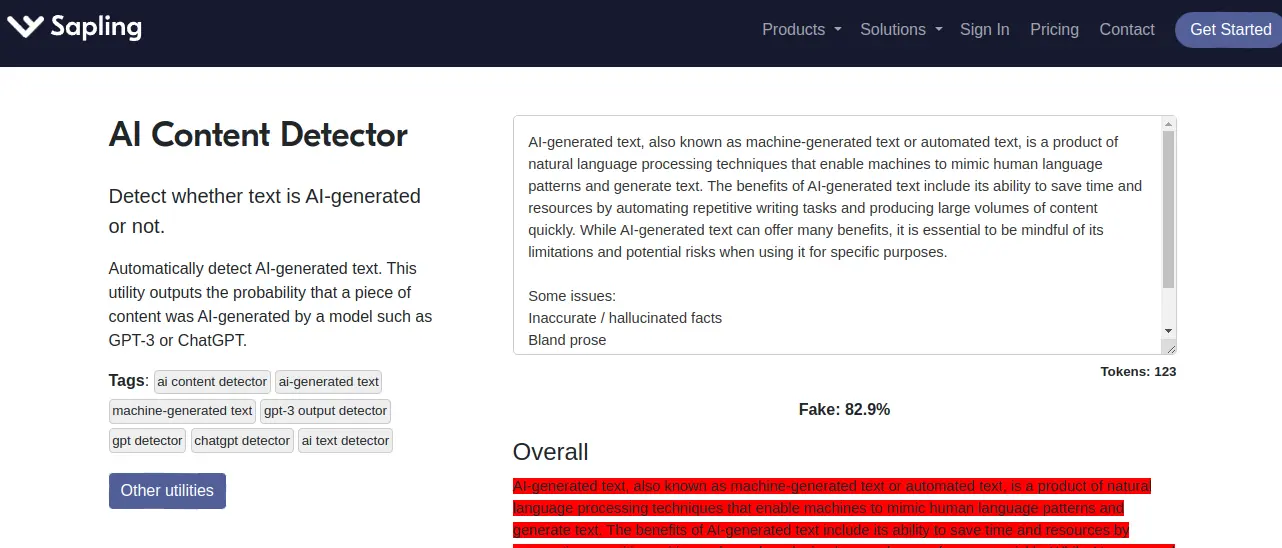
AI-generated text, also known as machine-generated text or automated text, is a product of natural language processing techniques that enable machines to mimic human language patterns and generate text. The benefits of AI-generated text include its ability to save time and resources by automating repetitive writing tasks and producing large volumes of content quickly.
While AI-generated text can offer many benefits, it is essential to be mindful of its limitations and potential risks when using it for specific purposes.
This tool automatically detects AI-generated text. This utility outputs the probability that a piece of content was AI-generated by a model such as GPT-3 or Chat GPT.
No current AI content detector (including Sapling's) should be used as a standalone check to determine whether text is AI-generated or written by a human. False positives and false negatives will regularly occur.
Coming Soon Features : Increased text length limit. Improved accuracy for shorter texts.
Key Features:
- Provides top-notch grammar and spell-checking capabilities
- Chrome and Docs extensions and add-ons available
- Uses natural language processing to create high-quality content such as emails and blogs
- Offers fast and efficient messaging support
- Can be integrated with more than 40 websites and applications
7. AI Content Detector (Free) - Detect GPT-3 + ChatGPT - Corrector
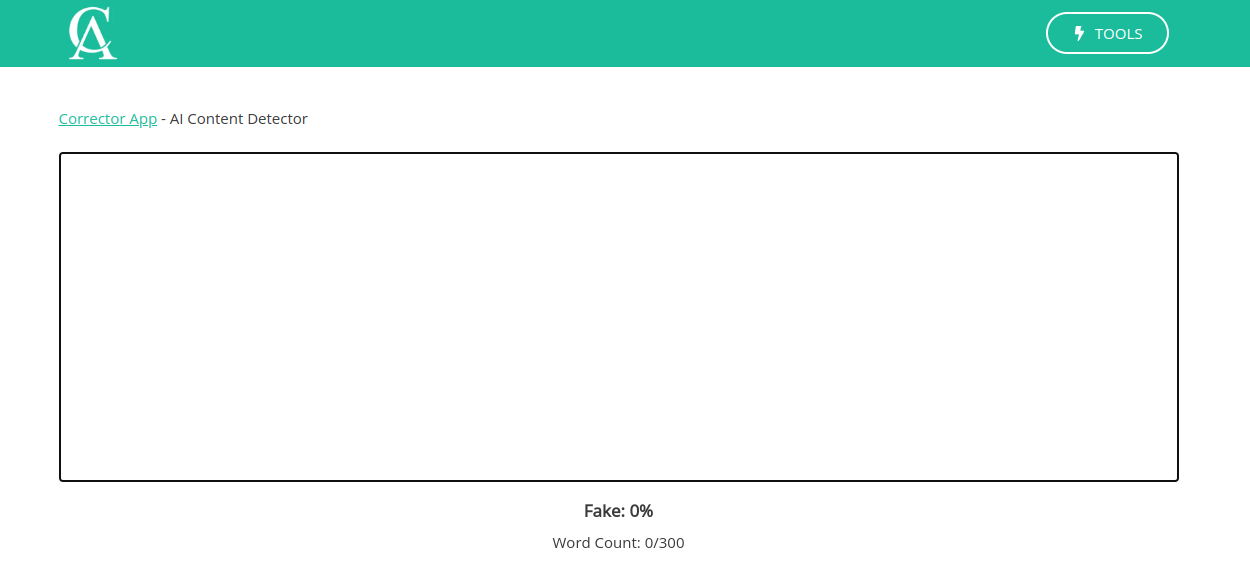
Our GPT text detector free tool is a powerful and intuitive way to detect fake news articles, homework, content, and web pages generated by ChatGPT. It is specifically designed to quickly identify if the text has been partially or completely created using a GPT-3 algorithm.
Our AI content detector can help determine if a text document contains any fake segments, allowing you to verify its authenticity and accuracy easily. The tool is extremely easy to use, providing real-time feedback on the level of fake percentages contained in a given text. You must paste the text into the tool, which will do the rest for you.
With this free tool, you can trust that your texts are of the highest quality and authenticity before sharing them with others. Furthermore, our GPT text detector can also identify fraudulent content in documents, giving you peace of mind when publishing them online or elsewhere.
Key Features:
- Grammar and syntax checking: This feature analyzes the text for grammar and syntax errors such as incorrect verb forms, subject-verb agreement errors, missing commas, etc.
- Contextual checking: This feature analyzes the text to identify errors in the use of words that do not fit the context. For example, it can detect if the wrong word is used in a sentence, or if a phrase is being used incorrectly.
- Plagiarism detection: This feature can identify whether the content is original or copied from other sources.
- Profanity filtering: This feature can identify and flag inappropriate or offensive language.
- Sentiment analysis: This feature can detect the overall sentiment of the text, including whether it is positive, negative, or neutral.
8. AI Detector by C@S: Chat GPT Detector Checks for AI Content
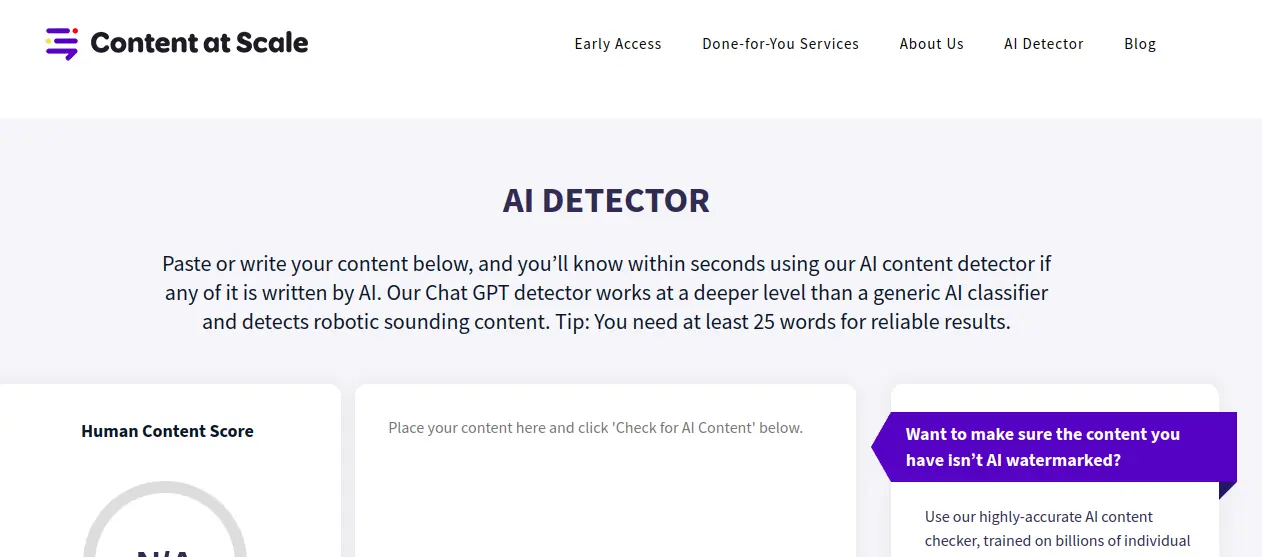
This proprietary content platform uses a mix of 3 AI engines, NLP and semantic analysis algorithms, crawls Google, and parses all the top ranking content to put entire long form SEO driven blog posts together.
This isn’t an AI writing assistant, this is a human level, long-form, blog post producing machine!
Want to make sure the content you have isn’t AI watermarked?
Use highly-accurate AI content checker, trained on billions of individual pages of data and words, to forecast if your content is AI generated, or humanly-optimized.
With AI watermarking coming on the scene and the need for a Chat GPT detector, you should be aware of AI detection scores for your content.
Know in seconds if the content you have reads like it is written by human's or if it comes from an AI writer like Chat GPT, GPT-3, etc.
Key Features:
- Supports multiple languages
- Created by SEO experts
- Utilizes multiple NLP models to create or detect AI content
- Tools are available for free use
9. Kazan SEO - AI GPT3 Detector

Considering companies' current focus on SEO, Kazan came up with its SEO-based content generation and optimization app. Apart from SEO, Kazan is capable of generating AI-based content too. It also uses the NLP model to generate and detect AI-based content.
Key Features:
- Can process GPT3 model
- Simple interface
- Far excels the other free tools out there
- Can scan content in bulk
- Free-to-use tool
10. Pass AI content detection - WordAi
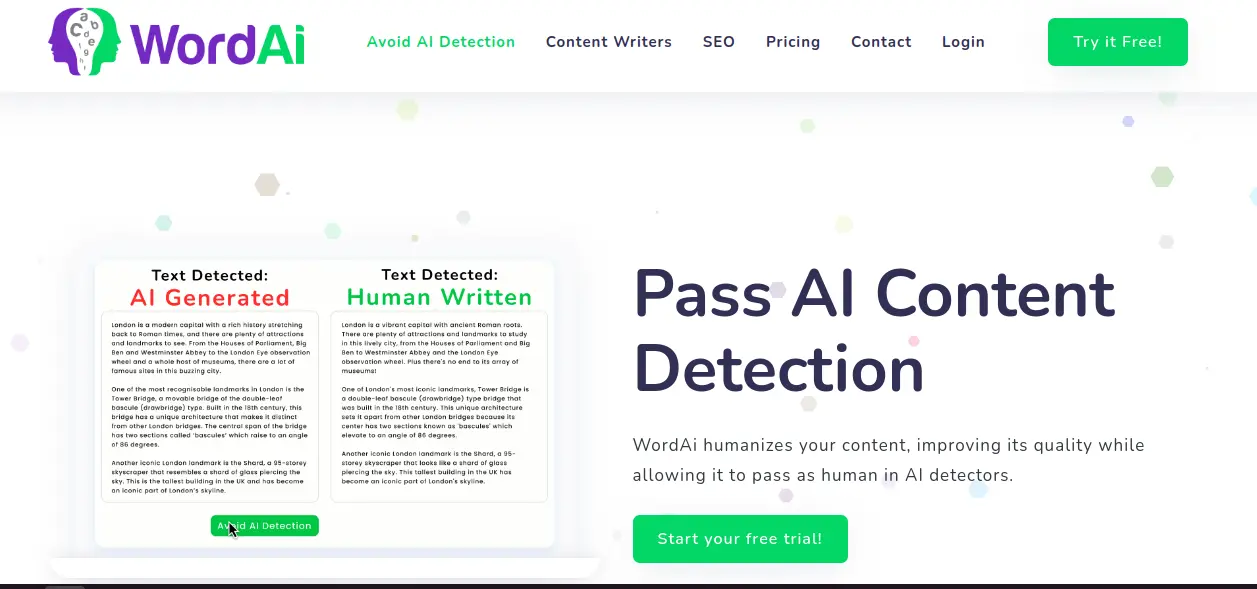
WordAi works with every single AI content generator. WordAi currently works for English texts of any kind. Whether you are writing a blog post, an essay, a cover letter, a production description, a report, or anything in between, WordAi can humanize your text. WordAi currently does not support code or foreign languages. Generally, code and non-English text pass AI detection tools already.
WordAi makes your content indistinguishable from human content, so you can expect it to pass AI detection tools at the same rate human content passes.
Different tools are more sensitive and may sometimes incorrectly classify human content as machine-written. If, for instance, a detection tool identifies human content as human-written 95% of the time, it will generally also identify WordAi content as human-written 95% of the time.
Most AI-generated content is already unique. However, if you are finding your AI tool is giving back plagiarized content, you can use WordAi to avoid plagiarism detection. You should first take your text and put it in Text Rewriter and then take the outputs and put that into Avoid AI Detection tool. Both tools are included in your WordAi subscription, so you can ensure your content is considered both unique and human-written.
Key Features:
- Plagiarism Checker: WordAi can detect plagiarism by comparing the input text with content on the web, making sure that the generated content is 100% original.
- Grammar and Spelling Check: WordAi employs an advanced grammar and spelling checker to ensure that the content is grammatically correct and free of spelling errors.
- Contextual Relevancy: WordAi understands the context of the content and generates text that is relevant to the topic at hand.
- Sentence Structure Analysis: WordAi analyzes the sentence structure to make sure that the content flows well and makes sense.
- Natural Language Processing: WordAi uses Natural Language Processing (NLP) to understand the meaning and context of the text, resulting in more human-like and engaging content.
11. AI-Generated Content Detection - Hive Moderation
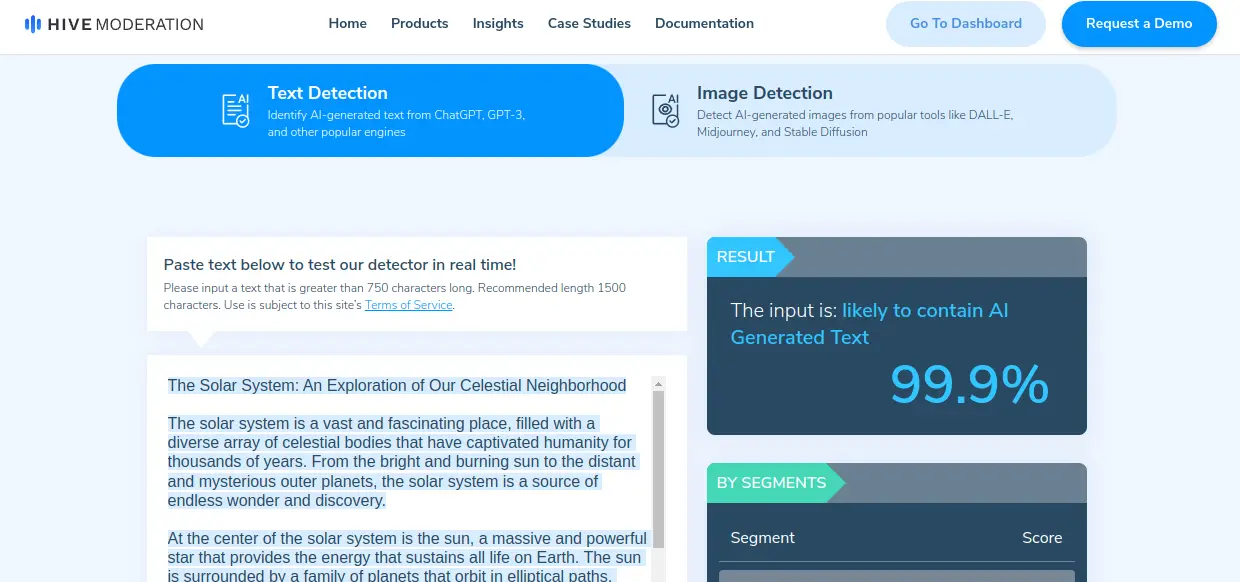
Machine learning models to detect AI-generated content.
Key Features:
DETECT PLAGIARISM -Teachers, schools, and educational programs can easily flag when students use AI to cheat on assignments.
ENACT SITE-WIDE BANS - Digital platforms can screen content as it is posted to implement site wide bans of AI-generated media
CREATE NEW FILTERS - Social platforms can identify and tag AI-generated content, allowing users the choice to filter it out of their feeds
What's best about this AI-Generated Content Detection Model
- Results are returned with a latency of <200ms
- market-leading model accuracy is >99%
- They've trained models on millions of examples across many content genres
ChatGPT SEO Prompts To Skyrocket Your Website Traffic
Criteria for selecting AI Content Detector Tools
When selecting AI Content Detector Tools, there are several criteria to consider, including:
- Accuracy: The most important factor in selecting an AI Content Detector Tool is its accuracy in detecting AI-generated content. Look for tools that have a high level of accuracy and can reliably distinguish between human-written and AI-generated content.
- Compatibility: Make sure that the tool is compatible with the type of AI-generated content you are trying to detect, such as AI content writing, detect AI writing, AI content generator, or Chat GPT output detector.
- Ease of use: The tool should be easy to use and integrate into your workflow. It should provide clear and concise results that are easy to understand.
- Customization: Look for tools that allow you to customize the detection criteria to match your specific needs. This can include setting thresholds for how much AI-generated content is acceptable, or defining specific types of AI-generated content to detect.
- Reporting: The tool should provide clear and detailed reports that show the results of the detection process. This can include information such as the percentage of AI-generated content detected, the source of the content, and the specific sections of the content that were flagged as AI-generated.
- Cost: Consider the cost of the tool, including any subscription or usage fees. Look for tools that provide good value for the price, and that fit within your budget.
- Reputation: Look for tools that have a good reputation in the industry and have been tested and validated by reputable sources. Check user reviews and ratings to get an idea of how well the tool performs in real-world scenarios.
FAQs - Top AI Content Detectors tools
Q: What is AI-generated content?
A: AI-generated content is any content that has been created by an artificial intelligence system, rather than a human being. This can include text, images, audio, and video.
Q: How do AI Content Detector tools work?
A: AI Content Detector tools use a range of algorithms and techniques to analyze content and identify patterns that are indicative of AI-generated content. These can include language patterns, syntax, and other markers that are characteristic of AI-generated content.
Q: How much do AI Content Detector tools cost?
A: The cost of AI Content Detector tools can vary depending on the specific tool and the pricing model used. Some tools may be available for free, while others may require a subscription or usage fee. It's important to research the pricing and features of each tool before making a decision.
Q: Can Chat GPT generated content be detected as plagiarism
Yes, Chat GPT-generated content can be detected as plagiarism using AI Content Detector tools such as Copyleaks. These tools are designed to analyze text and identify instances of plagiarism, whether the content has been generated by a human or an AI system.
When analyzing Chat GPT-generated content, these tools can identify similarities between the generated text and other sources, including previously published articles, websites, and academic papers. By detecting instances of plagiarism, these tools can help ensure that the content being produced is original and not simply a copy of existing material.
Find the Right Balance Between an AI and Human Content
At RedBlink, we understand that creating compelling content is key to connecting with your audience. While AI-generated content can be efficient and accurate, it lacks the emotional nuance and cultural references that human content creators bring to the table.
By utilizing the unique perspectives and experiences of human writers and designers, companies can create content that resonates with their audience on a personal level. This fosters a sense of connection and trust, building long-term relationships with your customers.
But finding the right balance between AI and human content can be a challenge. That's where RedBlink can help.
If you're considering implementing an AI-powered content detection system, Redblink's experienced team of ChatGPT developers can help. Our experts are ready to assist you in integrating AI and ChatGPT's capabilities into your existing systems or developing a custom solution tailored to your specific business needs. Contact us to learn more and get started today.
Introducing RedBlink's generative AI development services, the game-changer in the world of artificial intelligence. With a team of expert consultants, our AI consulting firm provides tailored solutions to businesses, leveraging cutting-edge technology. Our expertise in Generative AI and related niches is unmatched. Discover the potential impact of our services and revolutionize your business strategy today. Ready to dive more into generative AI? Learn how to build your own generative AI solutions from scratch.
Let us help you strike the right balance and deliver a personalized content experience that will connect with your audience and grow your business. Contact us today to learn more about our content marketing services.
HIPAA Compliant Healthcare Website Design: Best Practices
What Is HIPAA?
HIPAA (Health Insurance Portability and Accountability Act) is a United States federal law that was enacted in 1996. Its main purpose is to protect the privacy and security of patients' medical information. It is also known as the Kennedy-Kassebaum Act and was signed by President Bill Clinton.
HIPAA has several components, including the Privacy Rule, the Security Rule, the Enforcement Rule, and the Breach Notification Rule. The Privacy Rule sets standards for how protected health information (PHI) can be used and disclosed. The Security Rule establishes national standards for the security of electronic PHI. The Enforcement Rule outlines the penalties for noncompliance with HIPAA regulations. The Breach Notification Rule requires covered entities to notify patients if their PHI has been compromised.

HIPAA applies to healthcare providers, health plans, and healthcare clearinghouses, as well as to their business associates who may have access to PHI. The law requires these entities to safeguard patients' PHI and to implement appropriate administrative, physical, and technical safeguards to protect it.
Overall, HIPAA is intended to protect patients' privacy rights, ensure the security of their health information, and promote electronic transactions in the healthcare industry.
Importance of HIPAA Compliance in Healthcare Website Design
Healthcare website design is a critical component of user interaction of the medical facility and providing quality medical services to patients. With the increasing use of technology in healthcare and urgency in most cases, patients expect easy and secure access to their online medical services.
Website design regulations for healthcare were established to ensure the Patient data privacy in website design and apply to healthcare providers, including hospitals, clinics, insurance companies and website designing companies.
Top Reasons to Follow Medical Website Design Guidelines
- Protects patient confidentiality and privacy: Medical website design guidelines, including HIPAA compliance, help ensure that patient information remains confidential and secure.
- Complies with regulatory requirements: Medical websites must comply with various regulations, including HIPAA, to ensure that they meet the highest standards of patient care.
- Maintains patient trust and confidence: By following medical website design guidelines, healthcare providers can show their commitment to protecting patient information, which can help maintain patient trust and confidence in their services.
- Prevents unauthorized access and disclosure: Adhering to medical website design guidelines helps prevent unauthorized access, disclosure, or misuse of patient information, which is crucial in the digital age.
- Ensures safe transmission and storage of patient data: Medical website design guidelines require healthcare providers to implement secure methods of transmitting and storing patient data, such as encrypted email and secure file transfers.
- Limits access to patient data: By implementing user authentication and access controls, healthcare providers can limit access to patient data, ensuring that only authorized individuals can access it.
- Demonstrates a commitment to patient care: Following medical website design guidelines shows that healthcare providers take patient privacy and security seriously and are committed to providing the highest quality of patient care.
HIPAA Compliance Requirements for Healthcare Professionals
-
Understanding the Regulations and penalties
In order to be HIPAA compliant, healthcare professionals must understand the regulations and standards that govern the use of PHI (Protected Health Information) in their websites. This includes the HIPAA Privacy Rule, the HIPAA Security & Privacy Rule, and the HITECH Act, which establish the standards for protecting patient privacy and ensuring the security of electronic PHI.
The Breach Notification Rule is also an important aspect of the HIPAA regulations. This rule requires covered entities to notify individuals in the event of a breach of their PHI. It also sets requirements for how breaches must be reported to the Department of Health and Human Services (HHS) and the media.
The Enforcement Rule outlines the enforcement mechanisms that are available to the HHS to enforce the HIPAA regulations. This includes financial penalties for non-compliance and the requirement for covered entities to provide documentation and evidence of HIPAA compliance upon request.
-
Maintaining the Confidentiality and Privacy of Patient Information
Healthcare professionals must take steps to maintain the confidentiality and privacy of patient information on their websites. This includes implementing access controls to limit who has access to PHI, as well as using secure methods for transmitting and storing patient data.
-
Secure Transmission and Storage of Patient Data
Healthcare professionals must ensure that patient data is transmitted and stored securely in their websites. This includes using encryption techniques to protect data in transit and at rest, as well as regularly monitoring and auditing Healthcare website security measures to detect and prevent any unauthorized access.
-
Physical, Technical, and Administrative Safeguards
In order to be HIPAA compliant, healthcare professionals must implement a comprehensive set of physical, technical, and administrative safeguards to protect patient information in their websites. This includes using secure hosting providers, implementing strong encryption techniques, and regularly monitoring and auditing Healthcare website security measures.
-
User Authentication and Access Controls
HIPAA compliant website design must include robust user authentication and access control features, ensuring that only authorized users have access to protected health information (PHI). This entails using secure login methods and regularly monitoring and auditing user activity to detect and prevent any unauthorized access.
Designing a HIPAA-Compliant Healthcare Website
A Healthcare website design agency must take a comprehensive approach to designing a HIPAA-compliant healthcare website. Lets explore each of them:
-
Choosing a Secure Hosting Provider
In order to be HIPAA compliant, a healthcare website development company must choose a secure hosting that meets the standards for protecting PHI. This includes choosing a provider that uses encryption and other security measures to protect patient data and that is regularly audited and monitored to ensure compliance with HIPAA regulations.
-
Implementing Strong Encryption Techniques
A healthcare web design company must implement strong data encryption and storage techniques in their websites to protect patient data in transit and at rest. This includes using encryption for data stored on servers, as well as encryption for data transmitted over the internet.
-
Limiting Access to Patient Data
Healthcare professionals must limit access to their patient data in their websites by implementing access controls and using secure authentication methods. This involves the use of firewalls and password protection techniques to prevent unauthorized access to PHI (Protected Health Information) and maintain the confidentiality and privacy of patient information.
-
Using Secure Login and Authentication Methods
Medical Practitioners, doctors, nurses and other medical staff of the hospital must use secure login and authentication methods in their websites to ensure that only authorized users have access to PHI. This involves utilizing strong passwords, two-factor authentication, biometric authentication methods, and other security measures to prevent unauthorized access to patient data.
-
Regularly Monitoring and Auditing Security Measures
In order to be HIPAA compliant, healthcare website administrators must regularly monitor and audit their security measures to ensure that they are functioning as intended. This includes conducting regular security assessments and vulnerability scans, malware scanning as well as monitoring for any suspicious activity or breaches of patient data.
Staying Up-to-Date with HIPAA Regulations
Healthcare website administrators must monitor changes to HIPAA regulations as mentioned in their website : https://www.hhs.gov/hipaa/index.html in order to stay compliant with the latest requirements. This includes keeping up-to-date with any updates or changes to the regulations, as well as regularly reviewing their security measures to ensure that they are aligned with the latest standards.
-
Conducting Regular Security Audits and Risk Assessments
Healthcare professionals must conduct regular security audits and risk assessments in order to identify and address any vulnerabilities in their website design and security measures. This includes reviewing their systems and processes on a regular basis, as well as performing regular penetration testing and vulnerability scans to detect any potential threats.
-
Keeping Abreast of Cybersecurity Threats and Vulnerabilities
Healthcare professionals must stay informed of the latest cybersecurity threats and vulnerabilities in order to protect patient data in their websites. This includes monitoring for new and evolving cyberthreats, as well as implementing proactive measures to prevent and detect any security breaches. They should also be proactive as well to report such data breaches in the quickest manner.
Conclusion - HIPAA Compliance
-
The Importance of HIPAA Compliance for Healthcare Professionals
In conclusion, HIPAA compliance is essential for healthcare website designers to design websites that handle patient data. By following the Healthcare website development standards set forth by HIPAA, healthcare professionals can ensure that patient information is kept confidential and secure, and that patient trust and confidence in their services is maintained.
-
Taking Proactive Measures to Ensure Compliance
Healthcare professionals must take proactive measures to ensure HIPAA compliance in their website design. This includes implementing strong security measures, regularly monitoring and auditing their systems, and staying up-to-date with the latest regulations and best practices for protecting PHI. They should proactively report data breaches and security threats if there are any.
-
Ensuring Patient Trust and Confidence in Healthcare Services
By following HIPAA regulations and taking proactive measures to ensure HIPAA compliance in their website design, healthcare professionals can ensure patient trust and confidence in their services. This includes protecting patient privacy and maintaining the confidentiality of patient information, and demonstrating a commitment to the highest standards of patient care and security.
How RedBlink Can Help With HIPAA Compliant Medical Website Design Services
RedBlink is a leading web design company that specializes in creating websites for the healthcare industry. With a deep understanding of the unique needs and challenges facing healthcare organizations, RedBlink is committed to providing HIPAA compliant website design services that ensure the security and privacy of patient information.
RedBlink has more than 15 years of experience in healthcare website design and development. We fully understand the importance of HIPAA compliance and best practices for healthcare website design. We take the necessary measures to ensure that all of its designs meet the strict regulations set forth by the Department of Health and Human Services. From secure data transmission and storage to user authentication and access controls, RedBlink takes every step to ensure that patient information is protected and kept confidential.
The team at RedBlink uses the latest data encryption techniques and security measures to design websites that meet the highest standards for data protection. We always work closely with clients to ensure that all aspects of the website, from the hosting platform to the content management system, are secure and compliant with HIPAA regulations.
In addition to providing cutting-edge website design services, RedBlink stays up-to-date with HIPAA regulations to ensure that its designs remain compliant. The company conducts regular security audits and risk assessments to ensure that its designs are always in line with the latest standards.
RedBlink is dedicated to providing healthcare organizations with the tools they need to succeed in today's digital landscape. With its commitment to HIPAA compliance, RedBlink is the perfect choice for healthcare professionals looking to design a website that meets the highest standards for security and privacy.
So, don't settle for a cookie-cutter website that could fail to meet the unique requirements of the healthcare industry. Let RedBlink help you create a website that is secure, HIPAA compliant, and designed to meet the needs of your clients. Get in touch with us today to learn more about our specialized website design services for healthcare and medical professionals.
Landing Page Optimization: Best Practices, Tips - Guide [2024]
Landing pages are the backbone of digital marketing and the first impression for your brand. Investing in landing page optimization is an investment in your future." - Peep Laja, Founder of ConversionXL.
Increasing conversions on a website is achieved through landing page optimization (LPO). The goal of landing page optimization is to improve conversion goals of a given landing page by using methods such as A/B testing. Landing page optimization is a subset of conversion rate optimization (CRO).
Adding design elements, improving the landing page design, content, and information is an iterative process.Before launching a landing page, marketers can optimize landing pages and drive conversions. Broadly, LPO is the key to turning visitors into customers and repeat users, so don't miss the opportunity for success.
However, optimizing a landing page can be a complex process that involves multiple factors, from design and content to user experience and data analysis. In this guide, we'll explore the best practices and tips for landing page optimization to help you improve your conversion rates and maximize your ROI.
Landing Page Optimization And Conversion Optimization - What's the Relation
To optimize your landing page effectively, it's important to consider various entities such as design, messaging, user experience, and conversion optimization. A well-designed landing page should have an appealing visual layout that captures the user's attention and supports the messaging. The messaging on the landing page should be clear, concise, and focused on the benefits of the offer. The user experience of the landing page should be seamless, with a clear call-to-action and easy-to-navigate design.
In addition, conversion optimization plays a critical role in landing page optimization. A successful landing page not only generates traffic but also persuades users to take a desired action. To improve conversions, it's essential to conduct A/B testing to identify the most effective messaging, design, and call-to-action. By analyzing user behavior and data, you can identify areas of the landing page that may need improvement and make data-driven decisions to optimize it for better performance.
Overall, landing page optimization is a complex and multi-faceted process that requires careful attention to design, messaging, user experience, and conversion optimization. By following the best practices and tips outlined in this guide, you can create a landing page that resonates with your target audience, drives conversions, and helps your business grow online.
What Is Landing Page Optimization?
When it comes to digital marketing, landing page optimization is an essential part of the overall strategy. A landing page is a standalone webpage that a user is directed to after clicking on an advertisement or search result. The goal of a landing page is to convert visitors into leads or customers by encouraging them to take a specific action. There are several types of landing pages, each with a unique purpose and design.
Let’s understand LPO with the help of an example:
A company that sells outdoor gear wants to optimize its website to increase conversions. They create two versions of their landing page and use A/B testing to determine which version performs better. Version A has a hero image of a person hiking with the gear and a clear call-to-action button that says "Shop Now". Version B has a video showcasing the gear in action and a less prominent call-to-action button. After a week of testing, the company finds that version A has a higher conversion rate, so they decide to make it the permanent landing page.
What are the benefits of a Landing page?
One of the primary benefits of landing pages is their ability to provide a personalized experience for the user. By directing users to a targeted landing page, you can ensure that the content and messaging are relevant to their interests, needs, and preferences. This can help to build trust and credibility with potential customers, making them more likely to take the desired action.
Another benefit of landing pages is that they can be optimized for better performance. By conducting A/B testing, you can experiment with different design elements, content, and calls to action to determine which variations result in higher conversion rates. Over time, this optimization can lead to significant improvements in overall campaign performance and ROI.
Types Of Landing Pages
LPO increases brand awareness and provides opportunities for visitors to manage their preferences. The common types of landing pages are:
Click-through landing pages
A click-through landing page is designed to lead the user to a product or service. The page will highlight the benefits of the product or service and encourage the user to click through to the product page. An example of a click-through landing page is a page for a software product that lists the features and benefits of the software and encourages users to sign up for a free trial.
Lead Generation Landing Page:
A lead generation landing page is designed to capture information from the user, usually in exchange for a free resource, such as an ebook or whitepaper. The page will have a form for the user to fill out, and the information collected will be used to follow up with the user. An example of a lead generation landing page is a page for a marketing agency that offers a free marketing assessment in exchange for the user's contact information.
Squeeze page - Lead capture landing pages
A squeeze page is designed to capture the user's email address or other contact information. The page will typically have a simple design and a clear call to action, such as "Enter your email address to receive our newsletter." An example of a squeeze page is a page for a fashion brand that offers a discount in exchange for the user's email address.
Thank You Page
A thank you page is designed to thank the user for completing a specific action, such as filling out a form or making a purchase. The page may also provide additional resources or suggest related products or services. An example of a thank you page is a page for a nonprofit organization that thanks the user for making a donation and provides additional information about the organization's mission.
Viral landing pages
These pages promote a brand through word-of-mouth marketing, with the goal of getting more visitors to sign up and spread the word. A successful viral landing page has unique content and prominent social icons for easy sharing.
Microsites
Microsites are supplementary websites to a larger site with their own vanity URL, often driven from paid ads or print/television ads. They're classified as landing pages because visitors are routed to their destinations. Good examples are Spotify's Year in Music and movie trailer sites.
Unsubscribe landing pages
These pages confirm unsubscription and offer an opportunity to manage preferences or reconsider the decision, retaining critical website sections such as the footer and main menu. A "Second Chance" button can be added to prompt resubscription.
Sales landing pages
A sales page is designed to sell a specific product or service. The page will provide a detailed description of the product or service, including features and benefits, and include a call to action to purchase. An example of a sales page is a page for a weight loss supplement that provides before-and-after photos and customer testimonials.
404 landing pages
404 errors can be turned into opportunities by making them interesting and informative, providing links to top-rated product pages, and using humor to direct visitors back to the homepage.
Each type of landing page serves a specific purpose, and it is important to choose the right type of landing page for your campaign goals. By optimizing your landing pages, you can increase the chances of converting visitors into leads and customers, ultimately driving business growth.
Starting With Landing Page Optimization - Key Factors To Consider
Optimizing a landing page is a crucial step in any digital marketing campaign. Before you start optimizing a new landing page, there are several important things to consider to ensure that your efforts are successful. Here are some key factors to keep in mind:
- Define Your Goals: What is the main objective of your landing page? Is it to generate leads, promote a new product, or encourage users to sign up for a newsletter? Defining your goals will help you determine what elements to prioritize and what metrics to track.
- Know Your Target Audience: Understanding your target audience is essential to creating a landing page that resonates with them. Conduct market research to identify their interests, pain points, and preferences. This will help you tailor your messaging and design to their needs and expectations.
- Choose the Right Traffic Source: Your landing page should be optimized for the specific traffic source that you are using, such as organic search, paid advertising, or social media. This can help to improve the relevance and quality of your traffic, leading to higher conversion rates.
- Craft an Effective Headline: Your headline is the first thing that users will see when they land on your page. It should be clear, concise, and attention-grabbing. Use active verbs and emphasize the benefits of your offer to encourage users to keep reading.
- Use High-Quality Visuals: Visuals, such as images and videos, can help to break up text and make your page more visually appealing. Use high-quality visuals that are relevant to your offer and that support your messaging.
- Test and Optimize: A/B testing can help you identify which elements of your landing page are working well and which could be improved. Use analytics tools to track user behavior, such as bounce rates, time on page, and conversion rates, and make data-driven decisions about how to optimize your page.
By considering these factors before you start optimizing your landing page, you can create a page that is tailored to your target audience and designed to drive conversions.
Improve Performance Of A Landing Page - Important Factors To Consider
Crafting an effective landing page is not rocket science. It just takes a little extra effort to make sure that what you create delivers results. it's important to consider many other factors outside of the website that can help improve a landing page's performance, such as:
Create a Personalized Landing Page That's Too Good to Refuse!
Your landing page is your chance to make a lasting first impression. A page that not only looks good, but presents irresistible offers that entice visitors to hand over their personal information.
The visually appealing page packs a punch with a captivating headline that urges users to act. A call-to-action or a button is an extra dose of excitement to the process.
Remember, your landing page should answer the all-important questions, such as "Will my target audience benefit from my offer?" and "Is my offer better than my competitors?" If you can answer these questions and create a landing page that's too good to refuse, you'll be reaping the rewards in no time!
Say Goodbye to Slow Load Time
We can't stress enough the importance of having a fast loading landing page. With just one second of delay, your business could potentially lose 7% in conversions and 11% in page views.
Not only does slow load time cost you valuable conversions, but it can also leave your visitors feeling frustrated and unsatisfied. Don't let a slow page be the reason for lost opportunities, take action to ensure a faster load time.
Revamp your visitor's journey with the best UX design
UX design is essential for creating a landing page that converts visitors into customers. Optimal design, flow, and overall feel can make a lasting impression and increase conversions. Streamlined navigation, minimized distractions, and a visually appealing design can transform a landing page into a conversion powerhouse. Elevate your landing page with a focus on UX design.
Create a sense of urgency and scarcity with your offer(s)
Tapping into the power of urgency and scarcity is a winning strategy for your landing pages. When you emphasize the popularity or limited availability of your products or services, you create a sense of urgency that drives visitors to take action before they miss out. The fear of losing out is a powerful motivator!
Check out this example from Instapage, where they use a countdown timer to build a sense of urgency to encourage visitors to sign up for webinars before it's too late. A powerful tool to drive conversions and make the most of your landing pages.
Unlock the Power of SEO for Your Landing Pages!
By paying attention to landing page SEO, you can unleash a secret weapon that can give your landing pages the visibility they deserve and drive leads like never before. It's not just about stuffing random keywords but making sure that your landing page aligns with what your visitors are searching for online. That's the secret to faster conversions.
Think about it, if you've created a landing page for homemade vegan chocolates, you want as many people as possible to visit your site and place orders. The solution? Sprinkle relevant keywords like homemade vegan chocolates in your page content, meta title, and description, and watch your landing page soar to the top of search engine results pages (SERPs). The more relevant your keywords are to your visitors' searches, the higher your chances of ranking and attracting leads.
Landing Page Mistakes To Avoid
Creating a landing page is a critical aspect of any digital marketing campaign. However, even small mistakes in the design or content of your landing page can have a significant impact on your conversion rates.
The top five mistakes to avoid are:
A Poorly Defined Call to Action (CTA):
A CTA is the most critical element of any landing page. A weak or poorly defined CTA can hurt conversion rates. It's crucial to ensure that your CTA is clear, visible, and placed above the fold to grab the user's attention. It should be action-oriented, specific, and easy to understand. Use active verbs like "Download," "Sign Up," or "Join Now" to create a sense of urgency and encourage users to take action.
Too Much Clutter:
Too much clutter on your landing page can make it difficult for users to find the information they need. This can cause users to lose interest and bounce off the page, ultimately hurting conversion rates. Keep the design clean and simple with minimal distractions. Use high-quality images and videos to break up the text and make the page visually appealing. Limit the number of form fields to only essential information.
Slow Page Load Time:
Slow page load times can lead to frustration and a poor user experience. It's essential to optimize your landing page for speed by reducing the size of images and videos, compressing files, and minimizing the number of HTTP requests. You can also use a content delivery network (CDN) to speed up page load times and improve the user experience.
Lack of Social Proof:
Social proof is a powerful tool to build trust and credibility with potential customers. Including customer reviews, testimonials, and case studies on your landing page can help to establish your brand as trustworthy and authoritative. According to a study by Nielsen, 92% of consumers trust recommendations from friends and family, while 70% trust online reviews from strangers.
Inconsistent Messaging:
The messaging on your landing page should be consistent with the ad or email that drove the user to the page. Inconsistent messaging can confuse users and make them feel misled, which can ultimately hurt conversion rates. Ensure that the headline, subheading, and body text of your landing page align with the messaging of your ads and emails.
To identify and overcome these mistakes, conduct A/B testing to see which variations of your landing page perform better.
Use analytics tools to track user behavior, such as bounce rates, time on page, and conversion rates, to make informed decisions about which changes to make. By avoiding these landing page mistakes and optimizing your pages for conversions, you can drive business growth and achieve your marketing goals.
Sources:
- https://blog.hubspot.com/marketing/landing-page-mistakes
- https://www.klientboost.com/landing-pages/landing-page-mistakes/
Final Thoughts - Landing Page Optimization
It's important to note that landing pages are just one piece of the larger conversion puzzle. They work in conjunction with other marketing channels, such as email, social media, and advertising, to drive traffic and generate leads. By integrating landing pages with these other channels, you can create a cohesive and effective marketing strategy that targets users at every stage of the buying journey.
In conclusion, landing pages are a critical component of any digital marketing campaign. By designing them with the user in mind, optimizing them for performance, and integrating them with other marketing channels, you can improve conversion rates, generate leads, and drive business growth.
Ready to take your landing page optimization to the next level? Partner with the expert- level digital marketing company having a strong portfolio of creating conversion driven landing pages.
At RedBlink, we design landing pages with these trendy conversion tactics.So, what are you waiting for? Get started now and see your conversion rates soar!

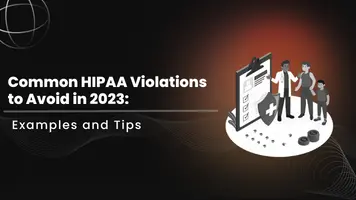
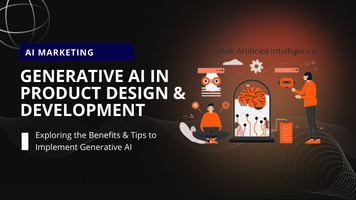
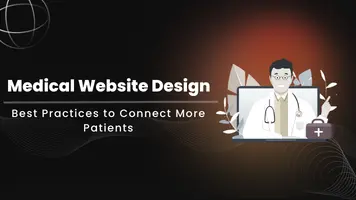

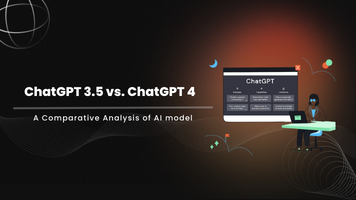
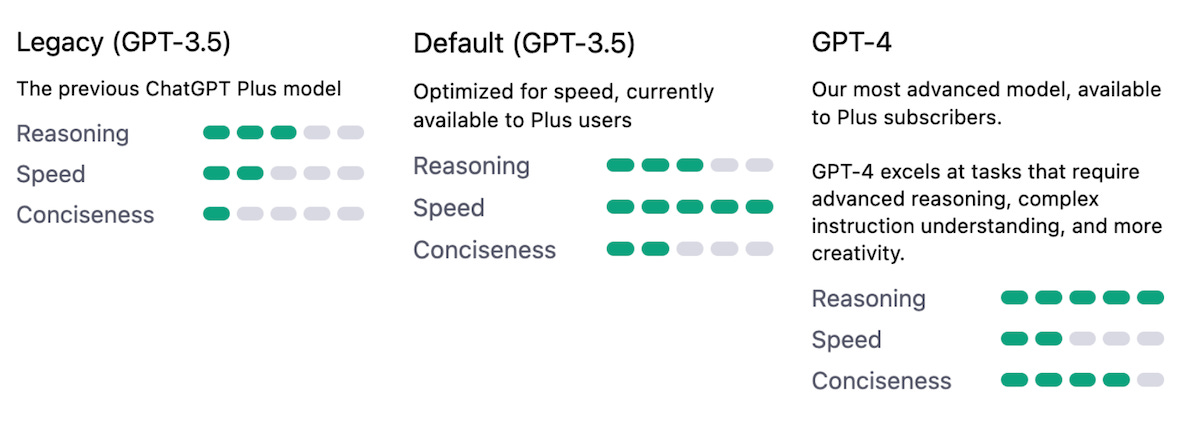
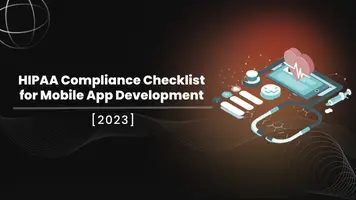
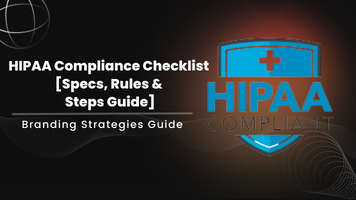
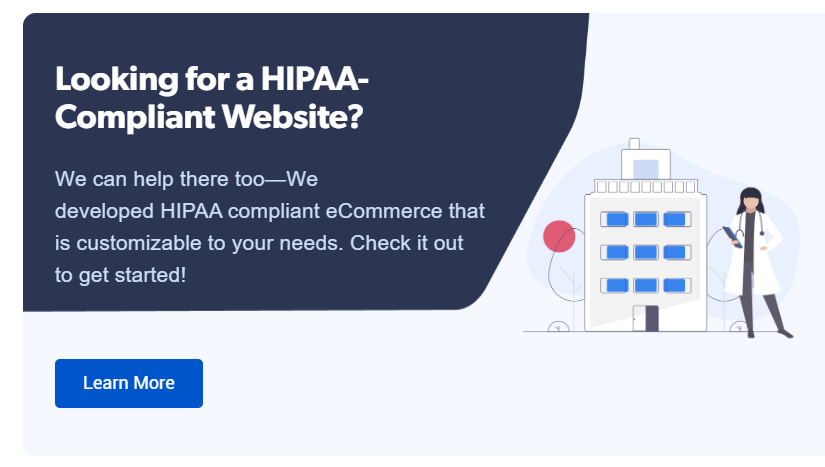
![10 AI Content Detector Tools to Detect ChatGPT Content [2023]](https://redblink.com/wp-content/uploads/2023/02/10-AI-Content-Detector-Tools-to-Detect-ChatGPT-Content-2023.webp)
